
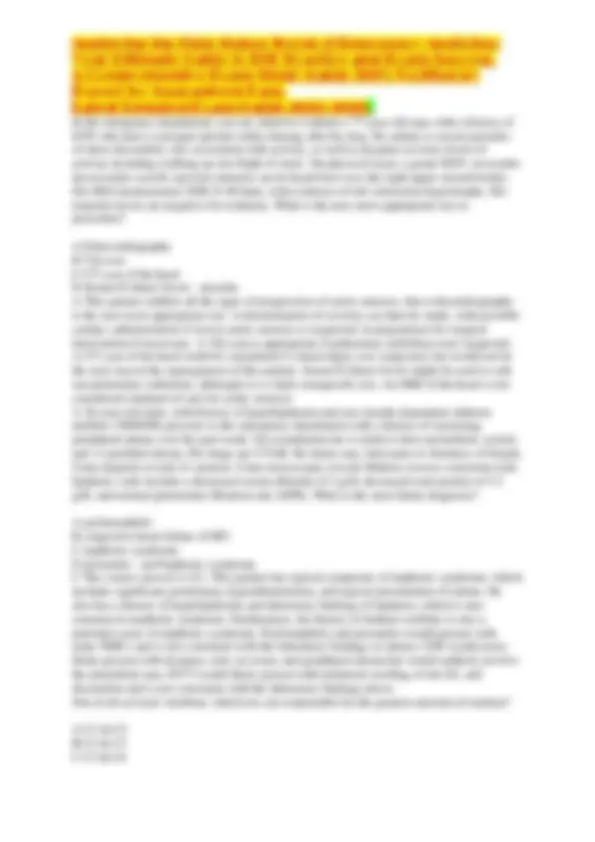
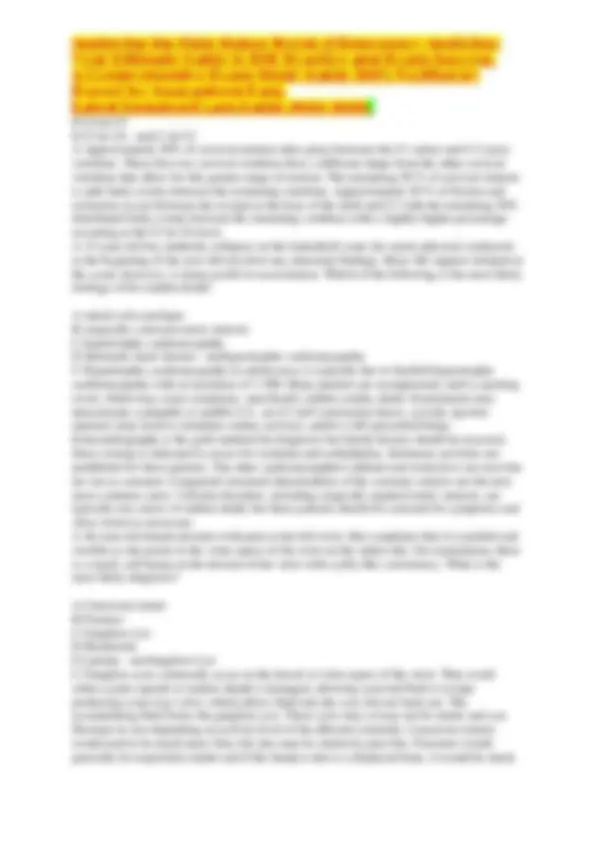
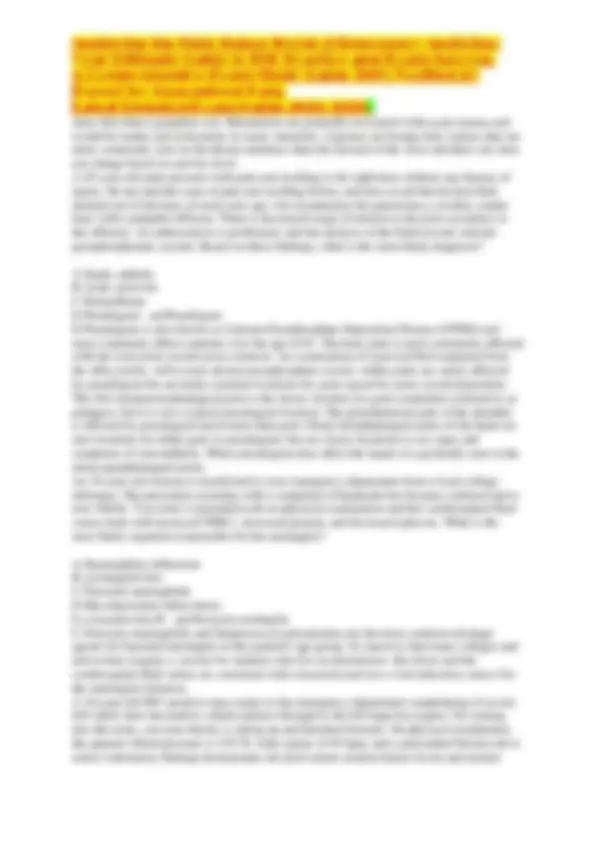
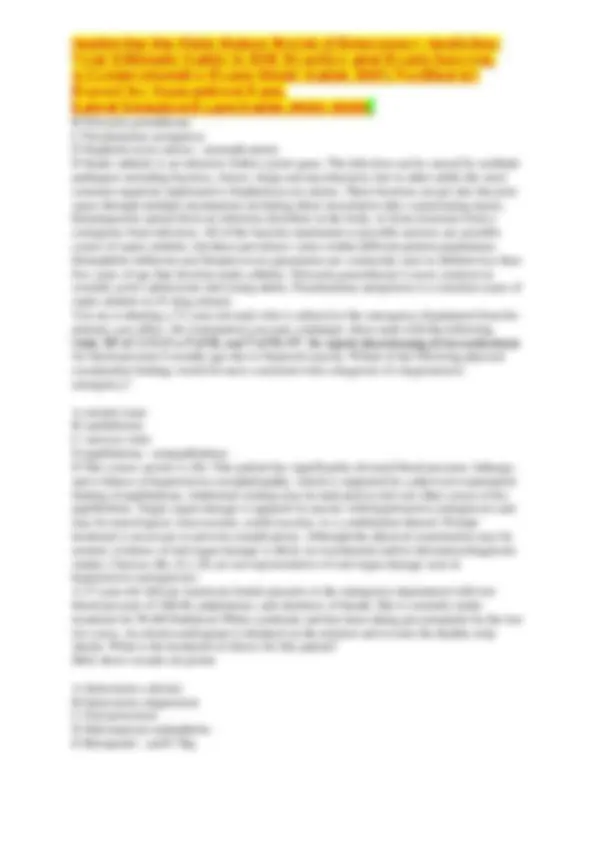
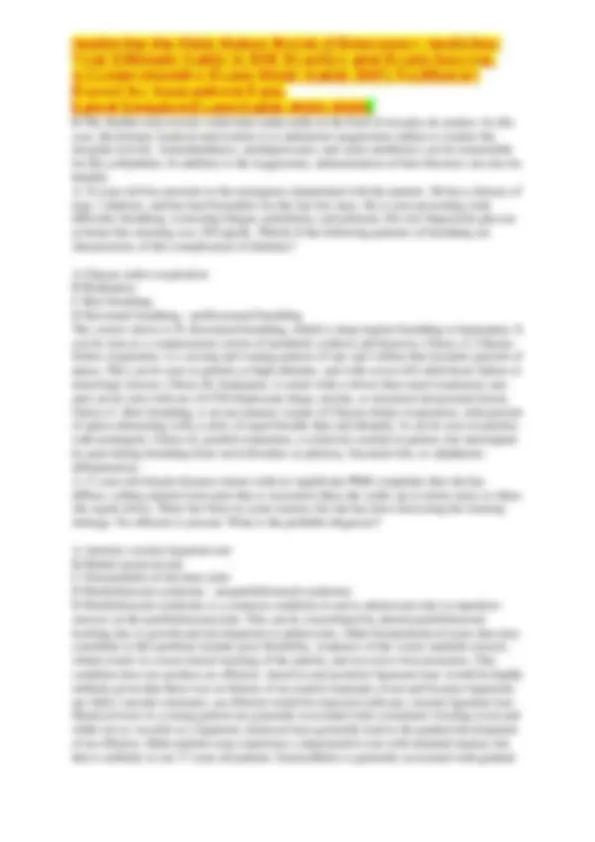
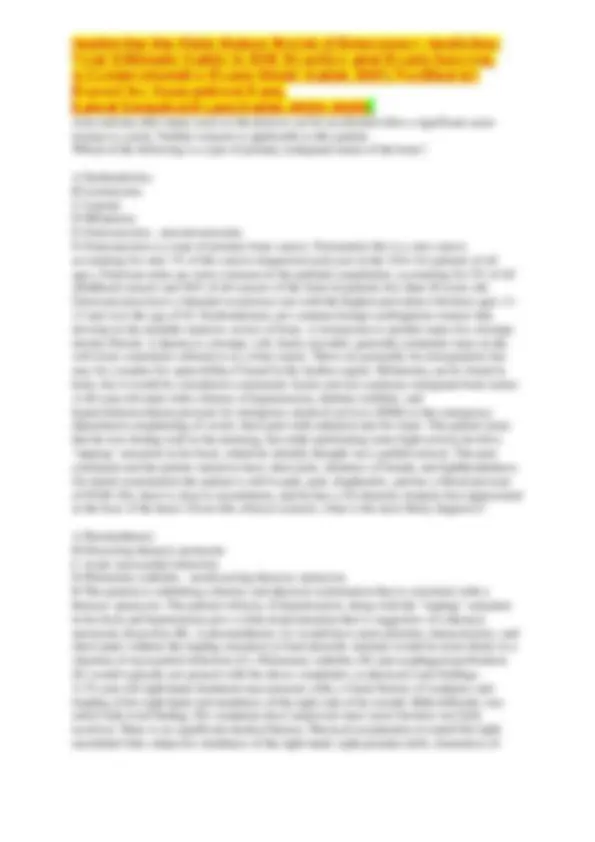
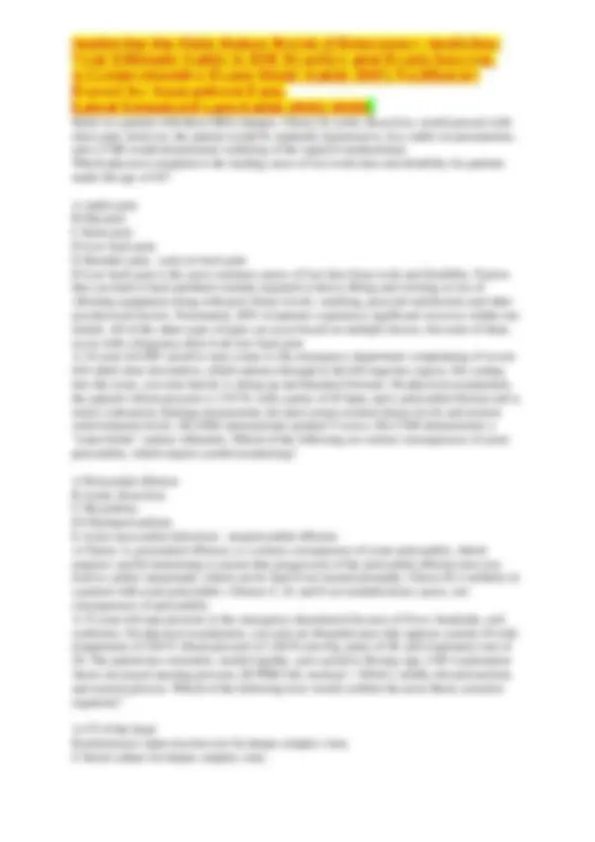
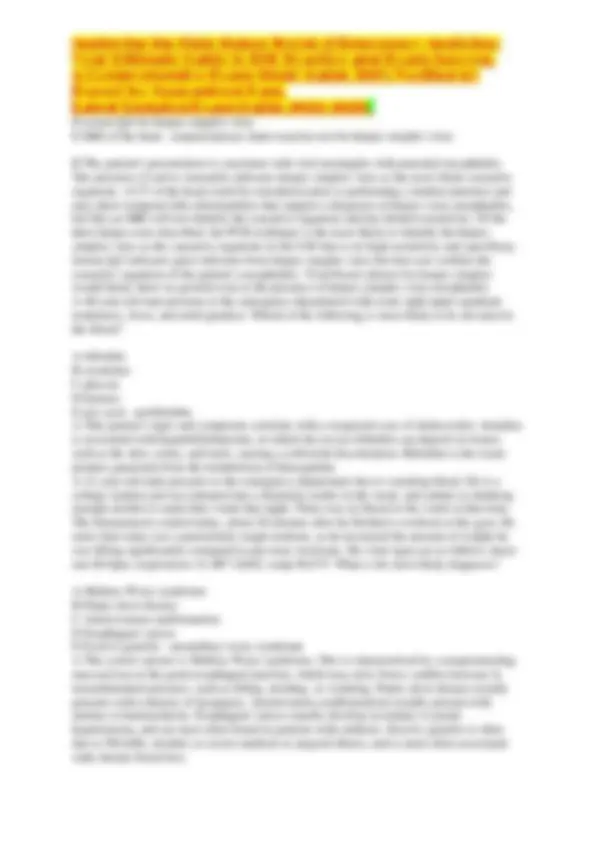
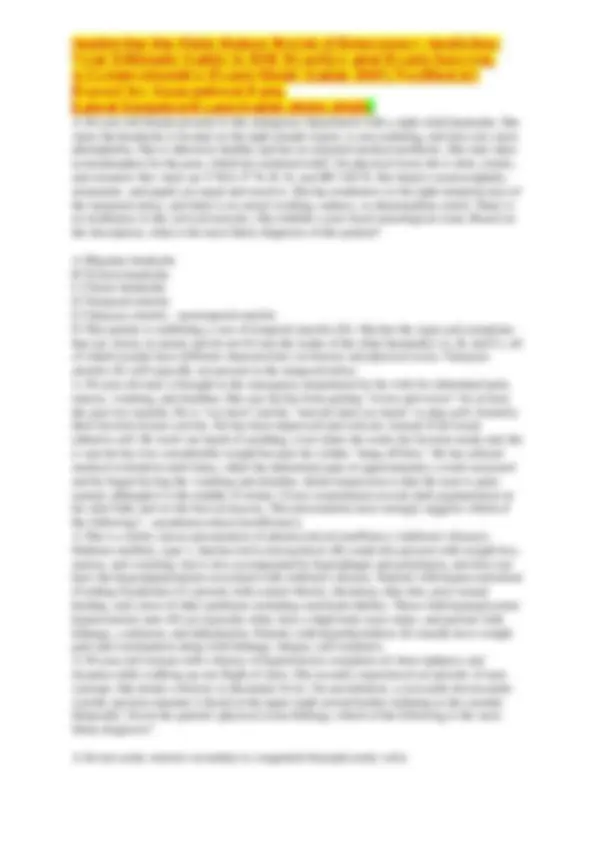
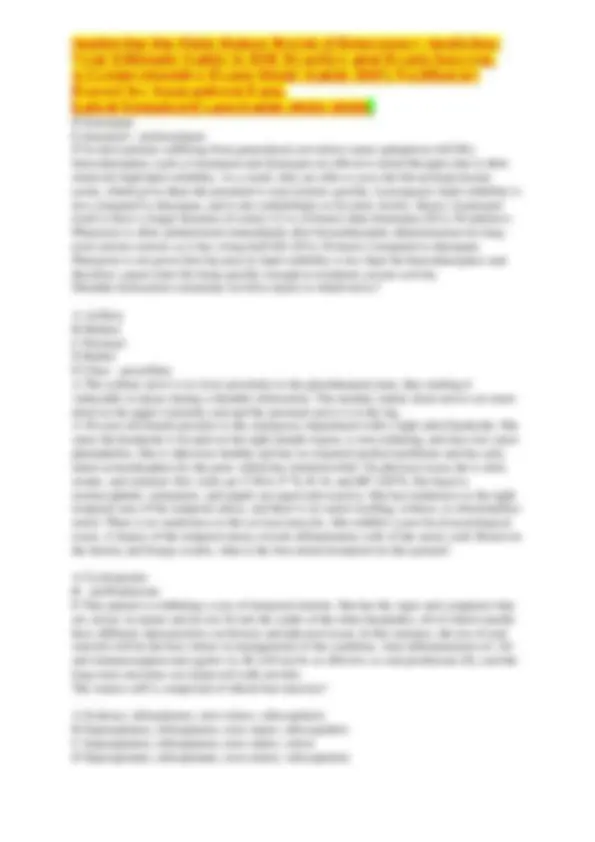
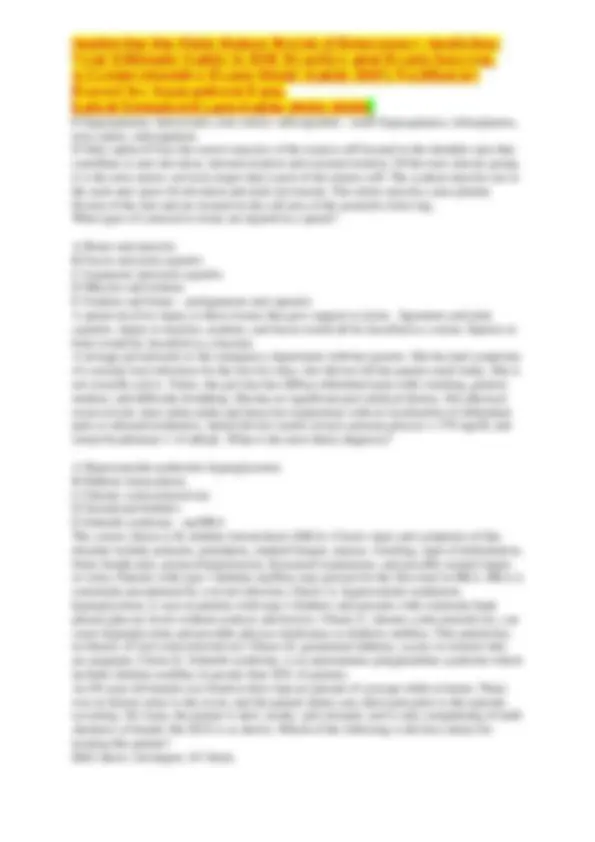
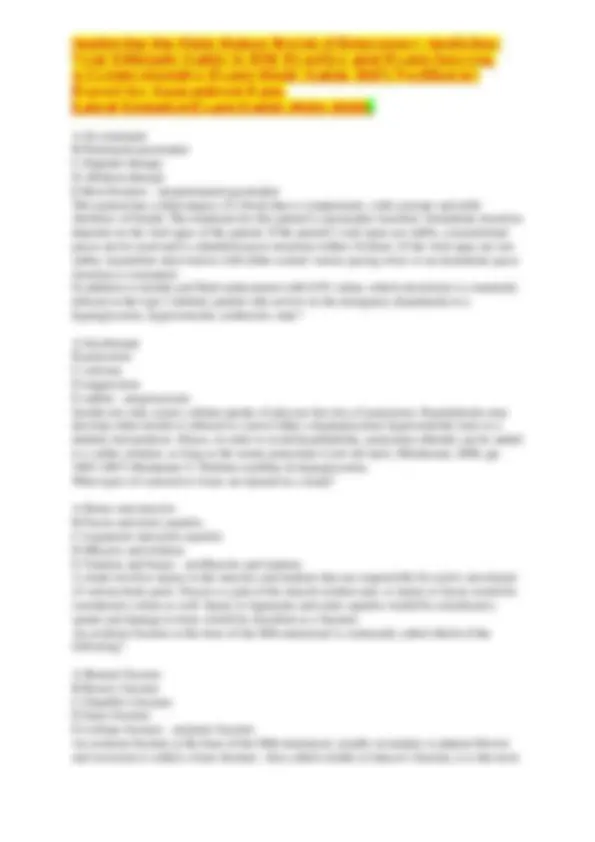
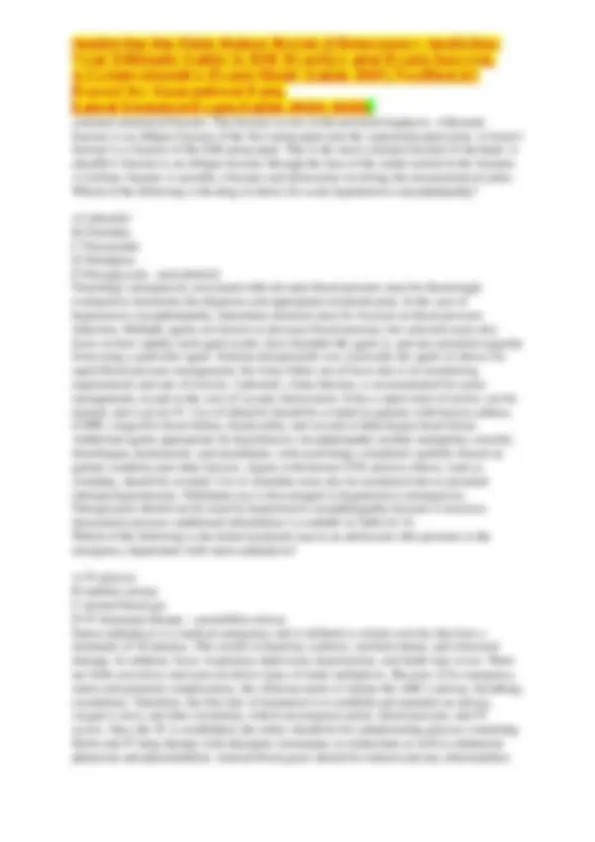
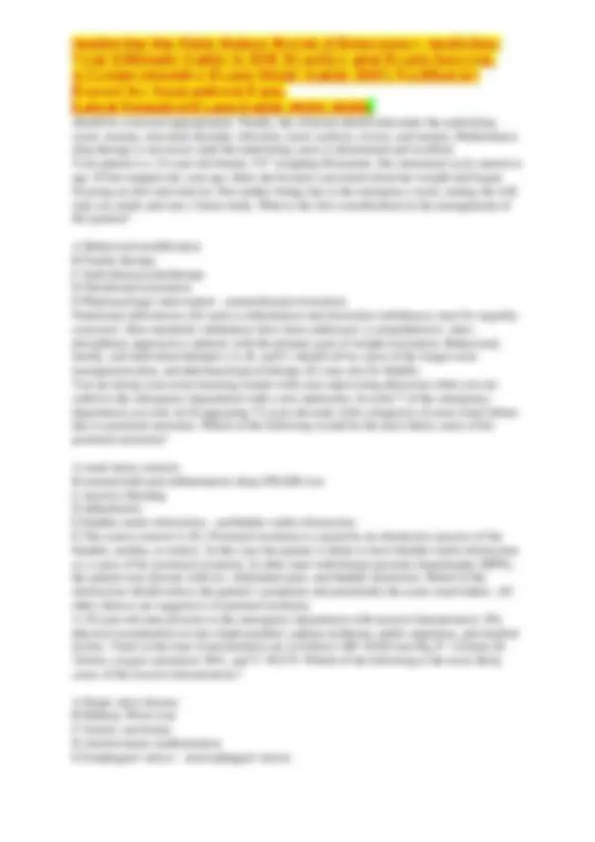
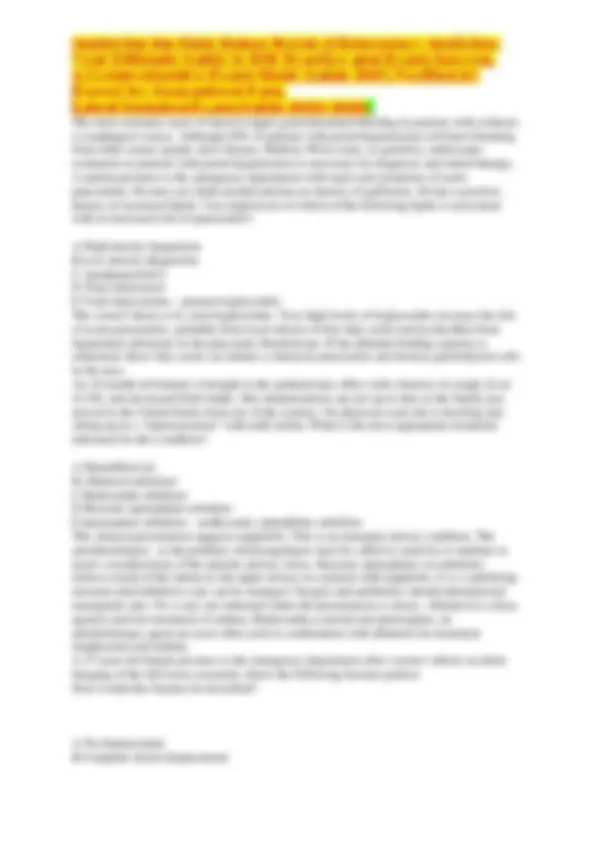
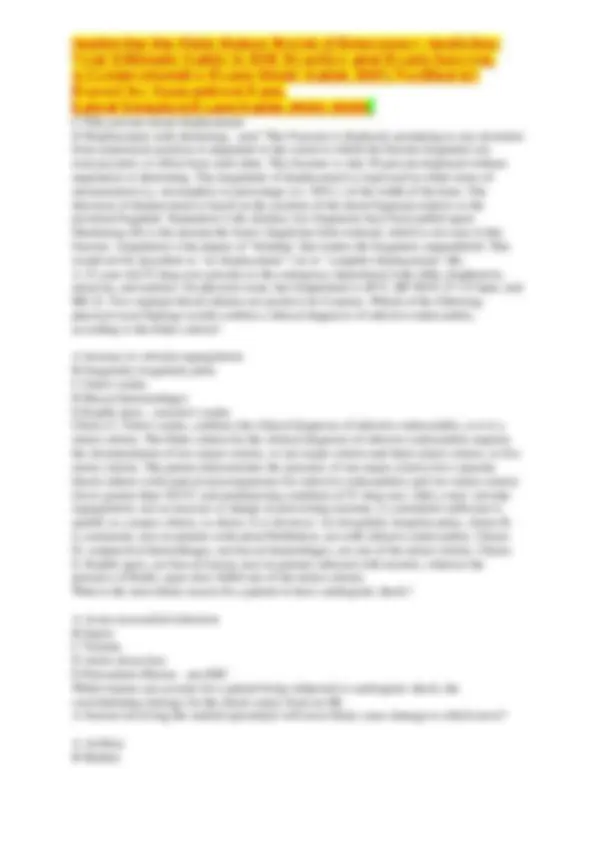

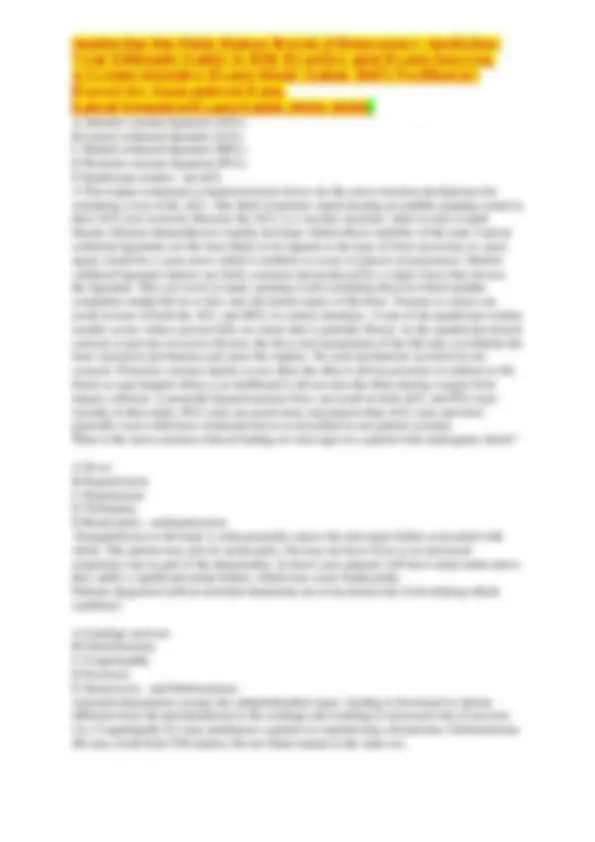
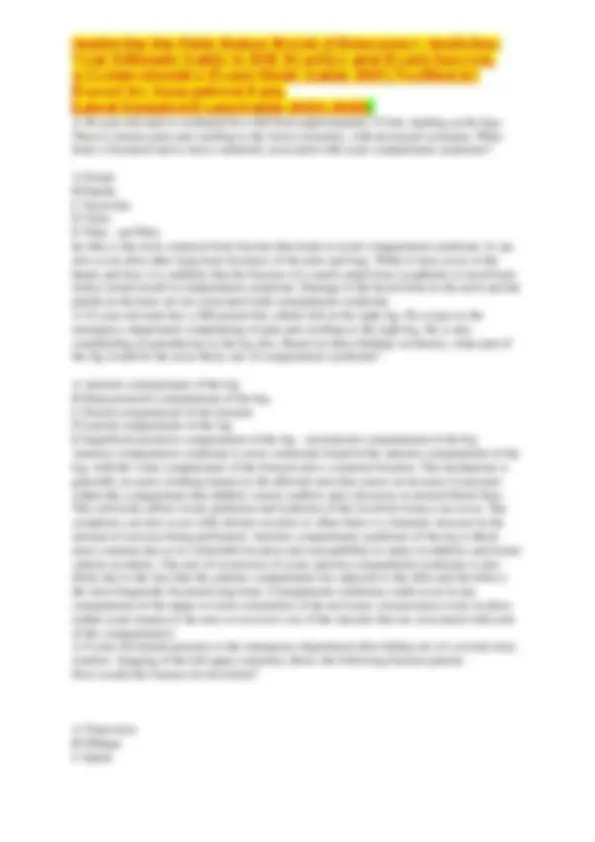
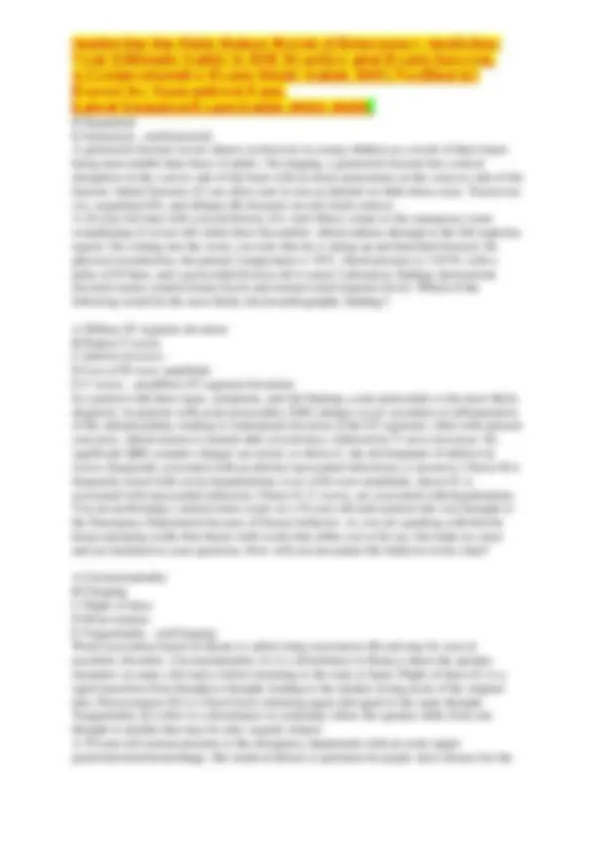
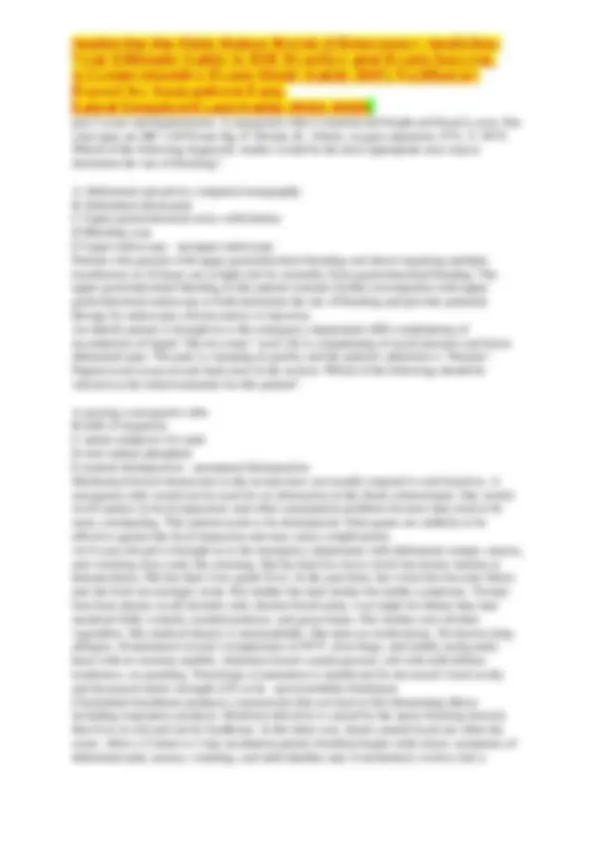
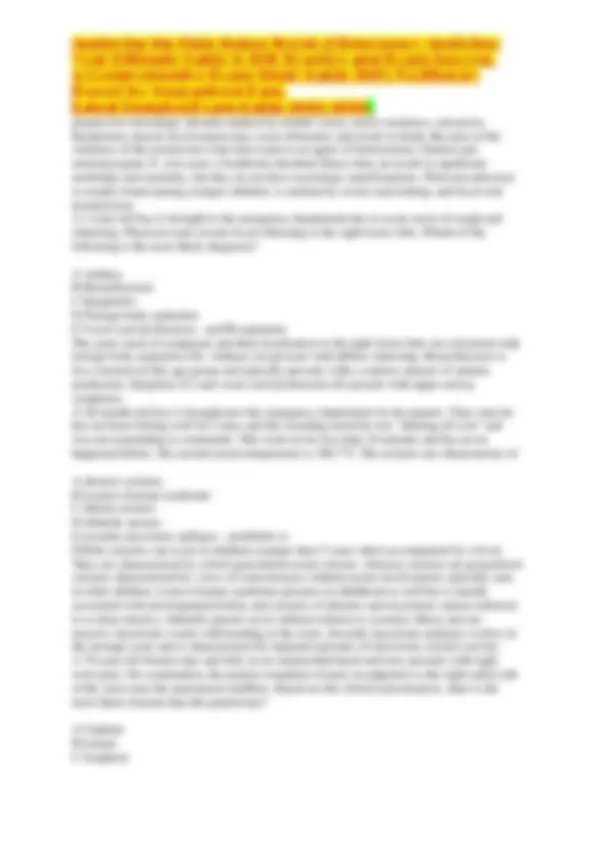
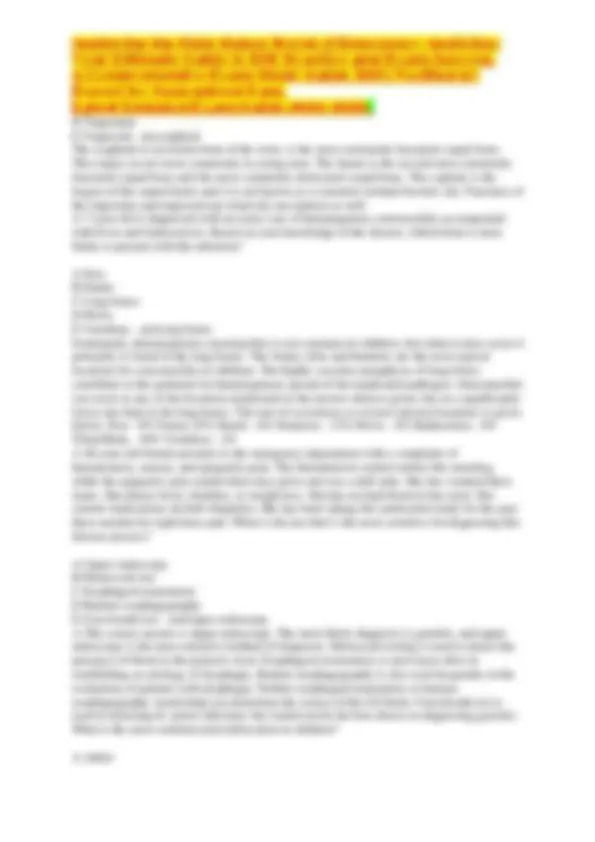
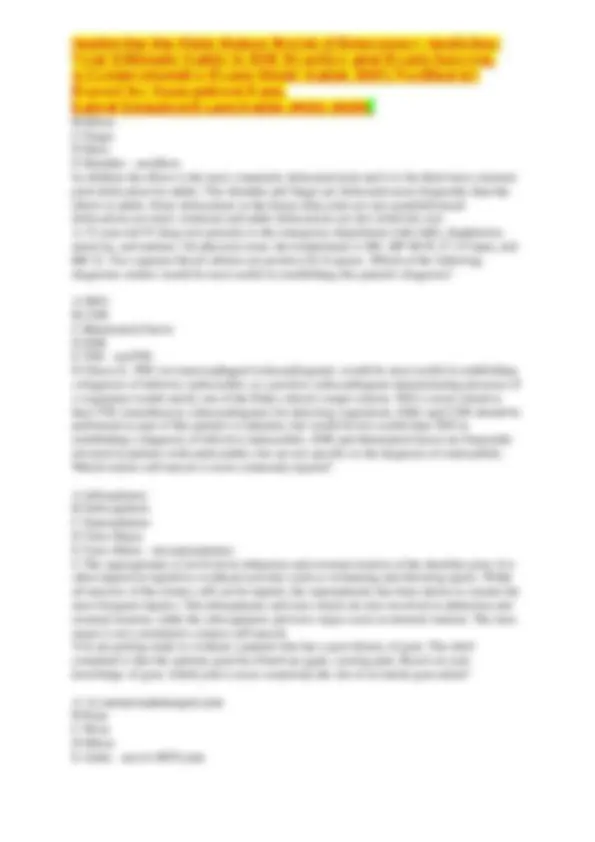
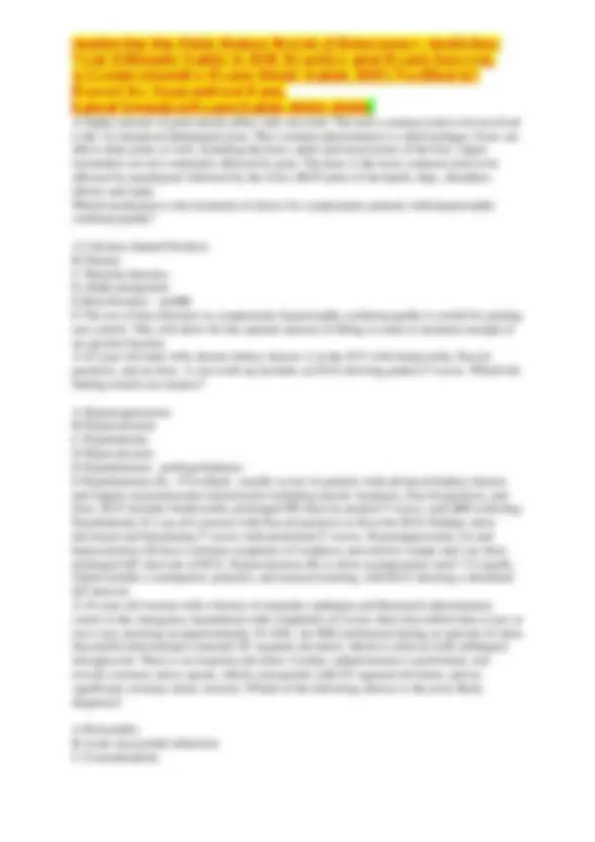
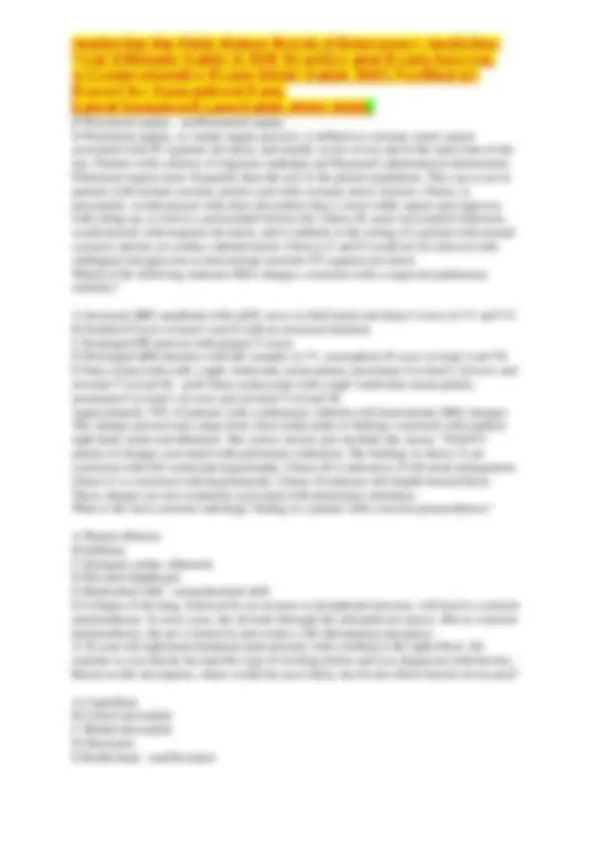
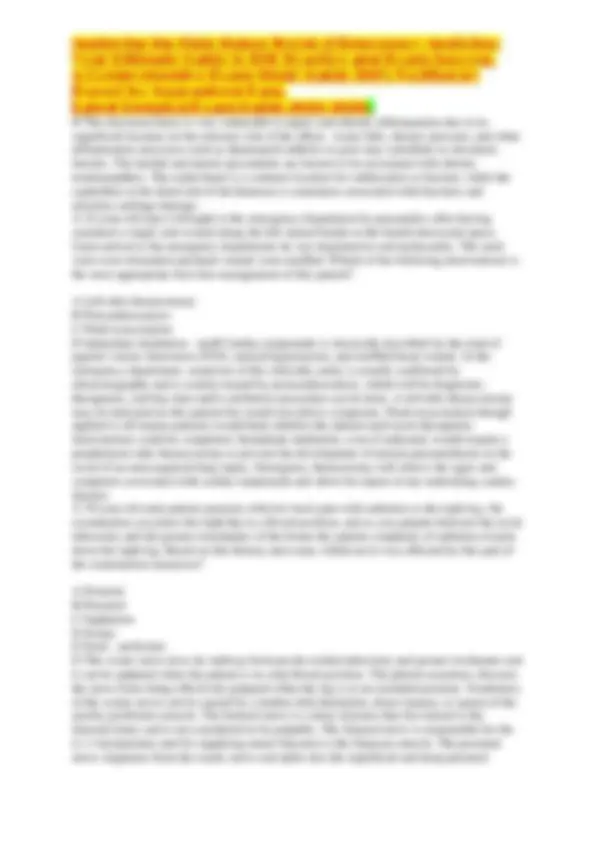
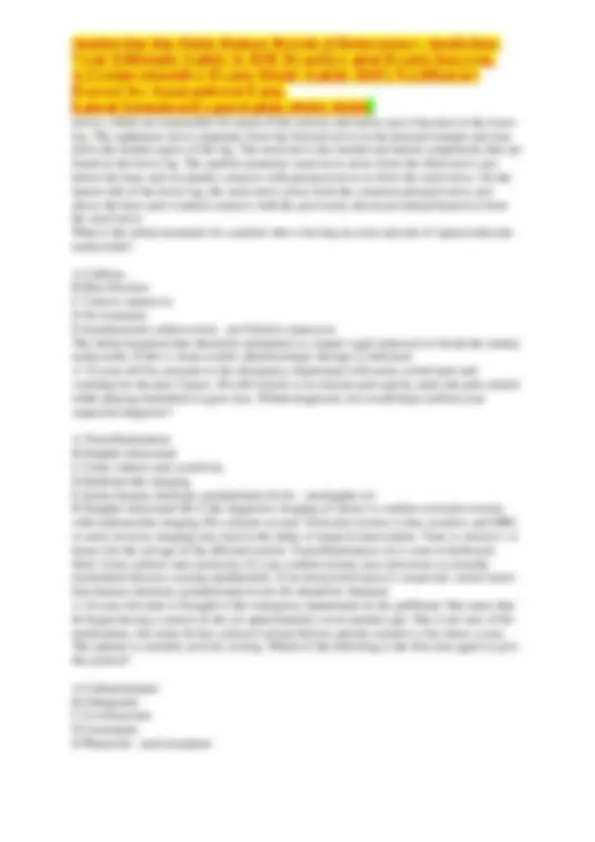
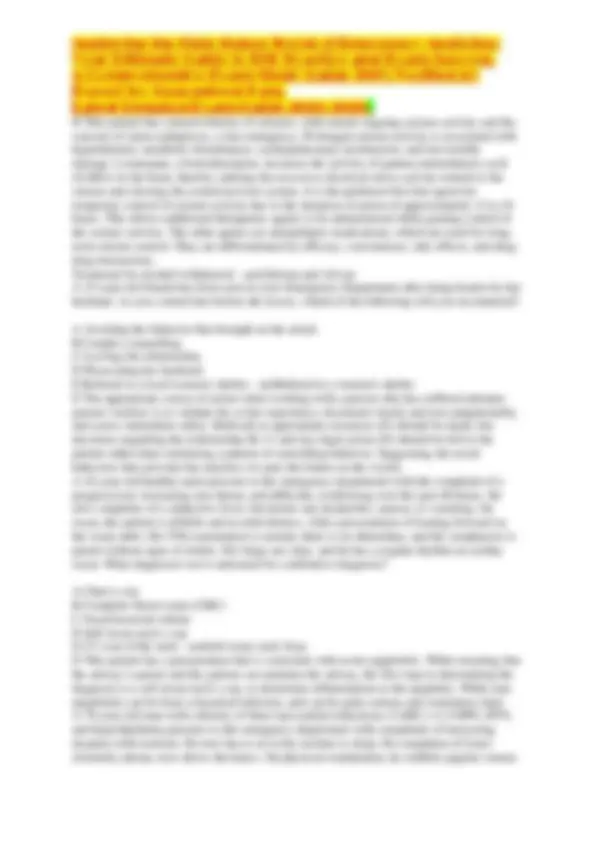
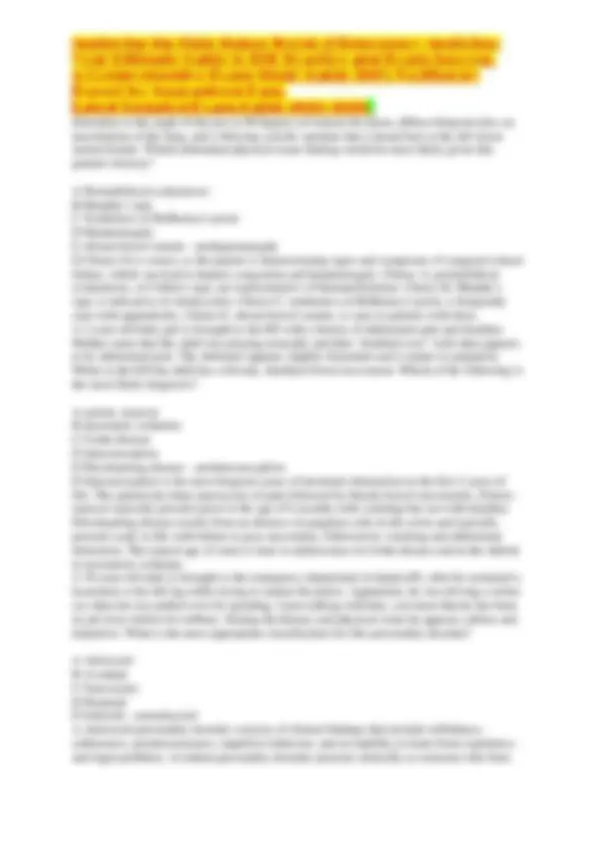

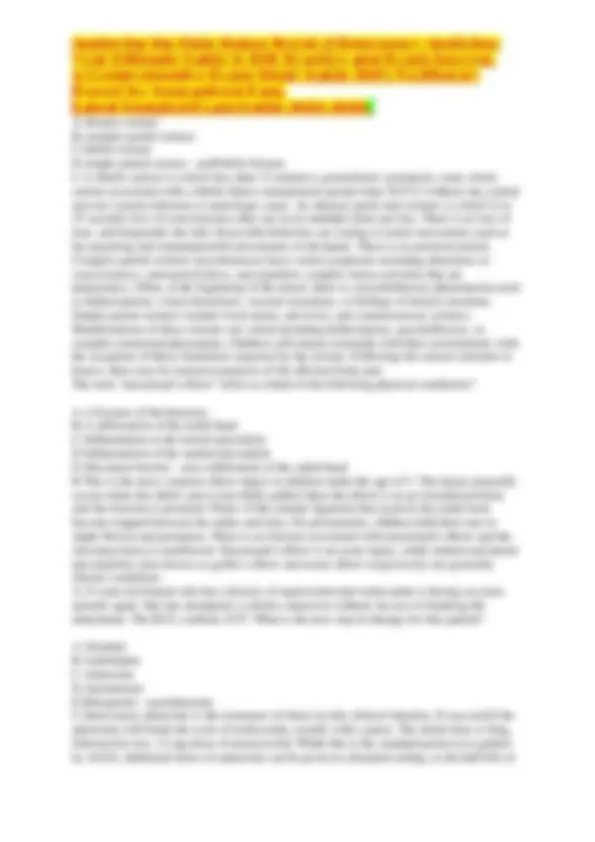
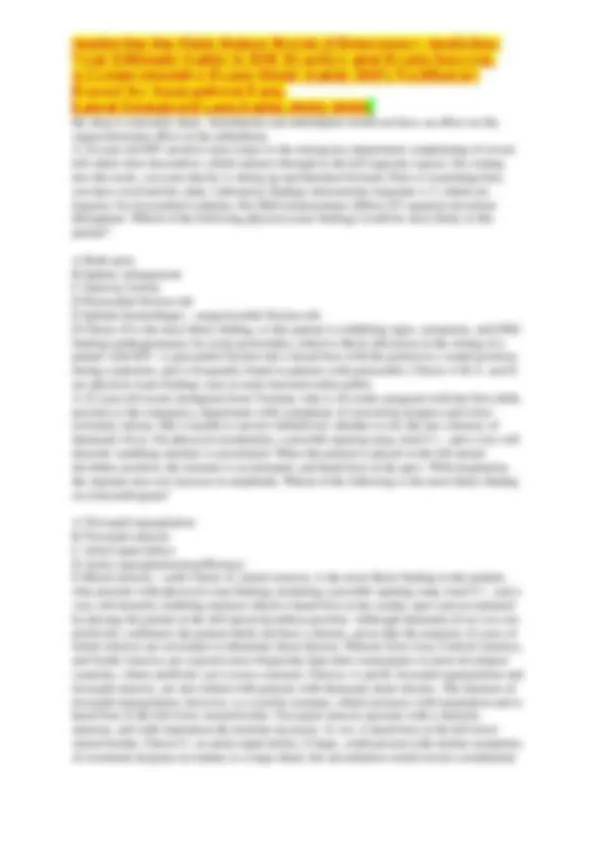
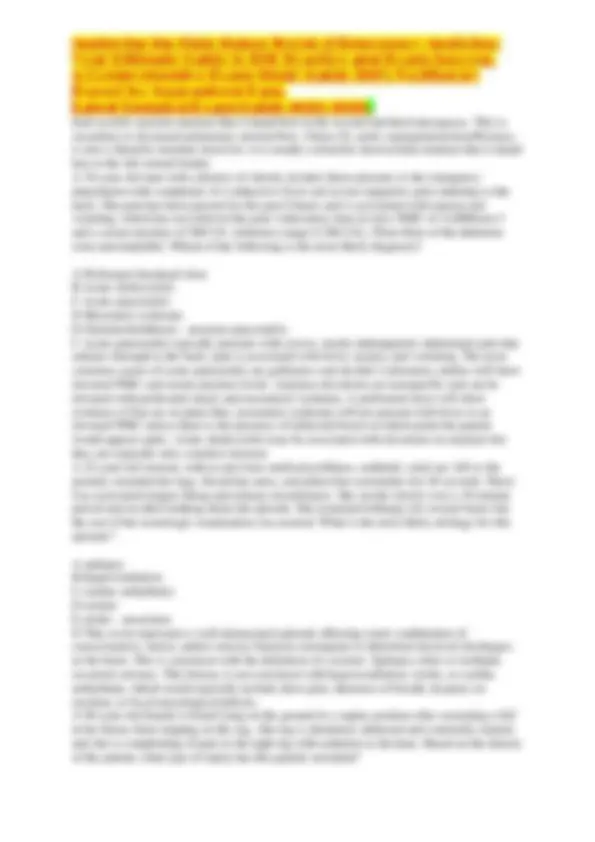
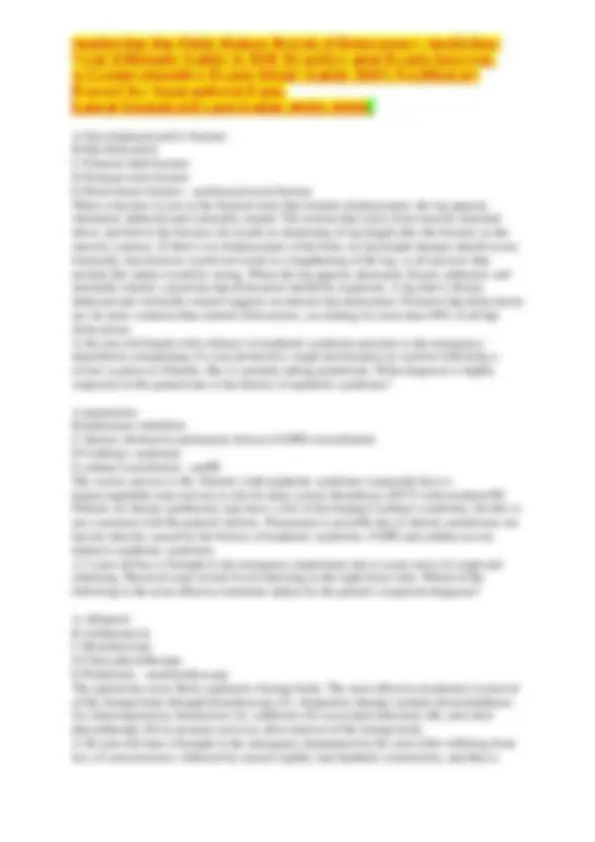
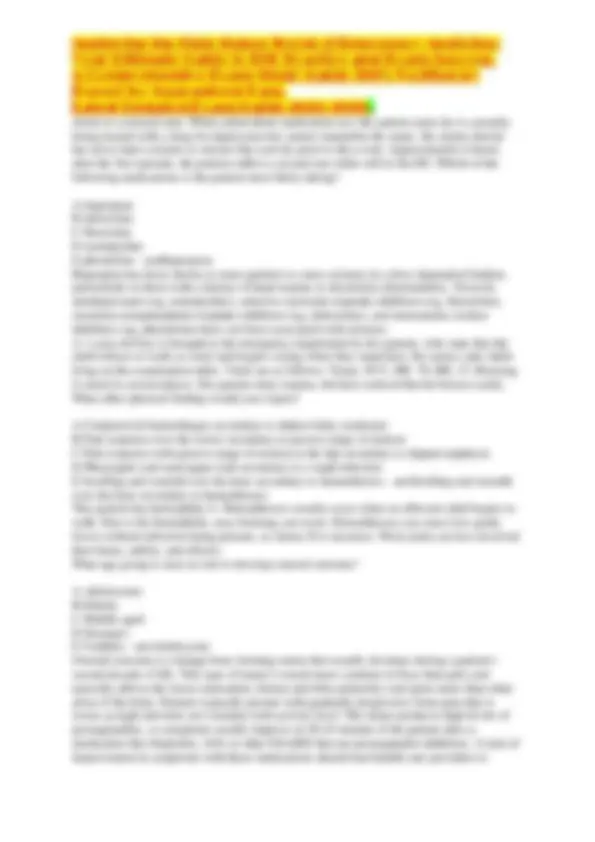
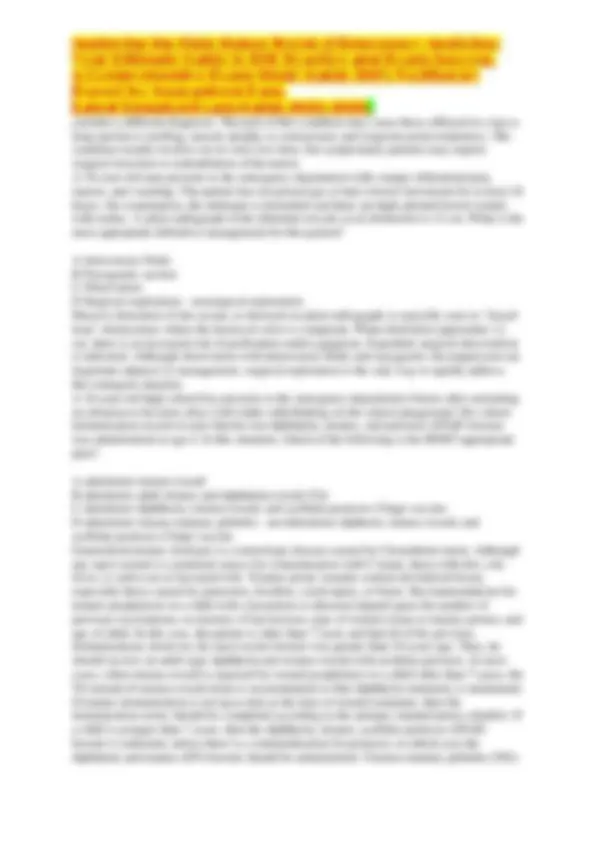
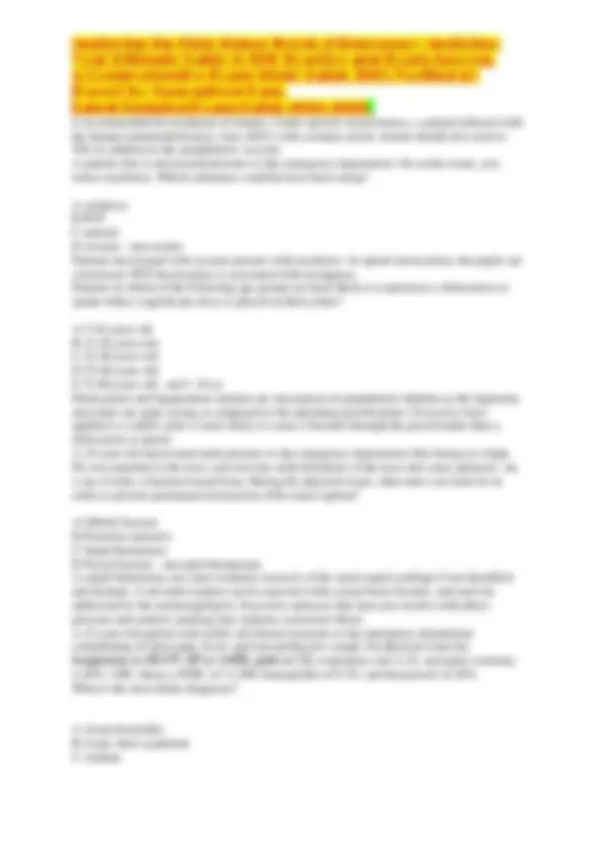
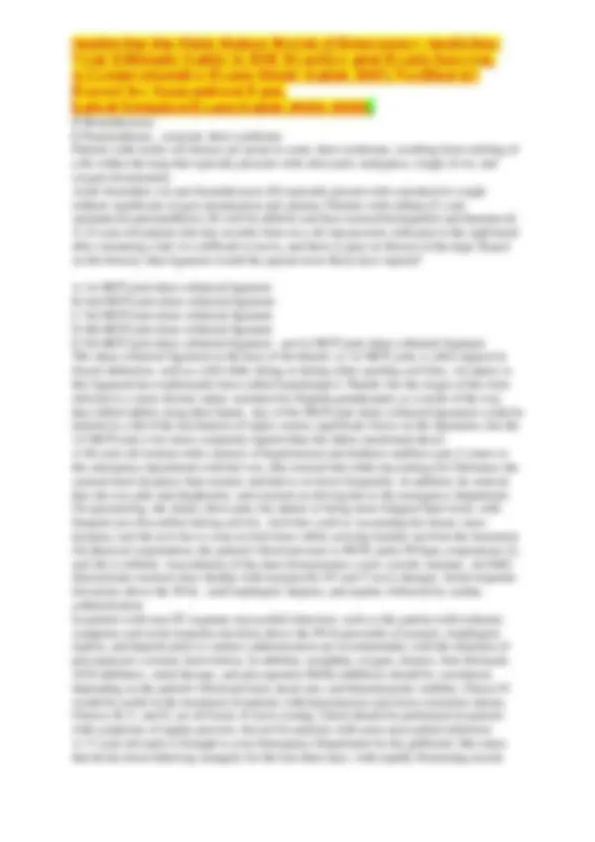
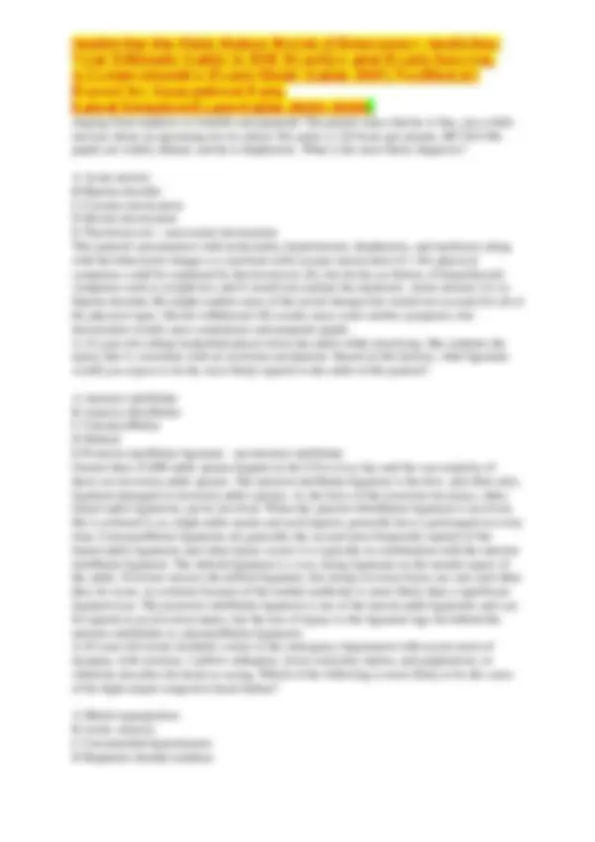
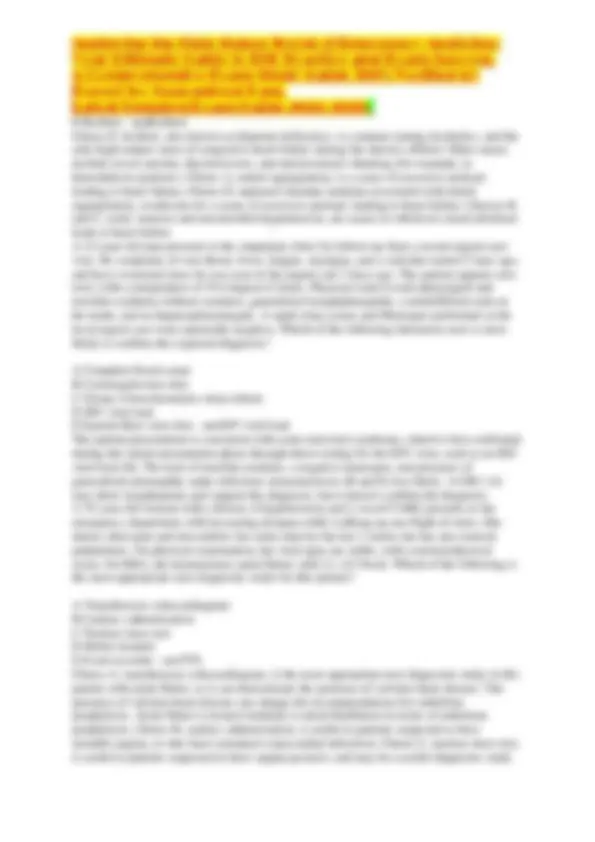
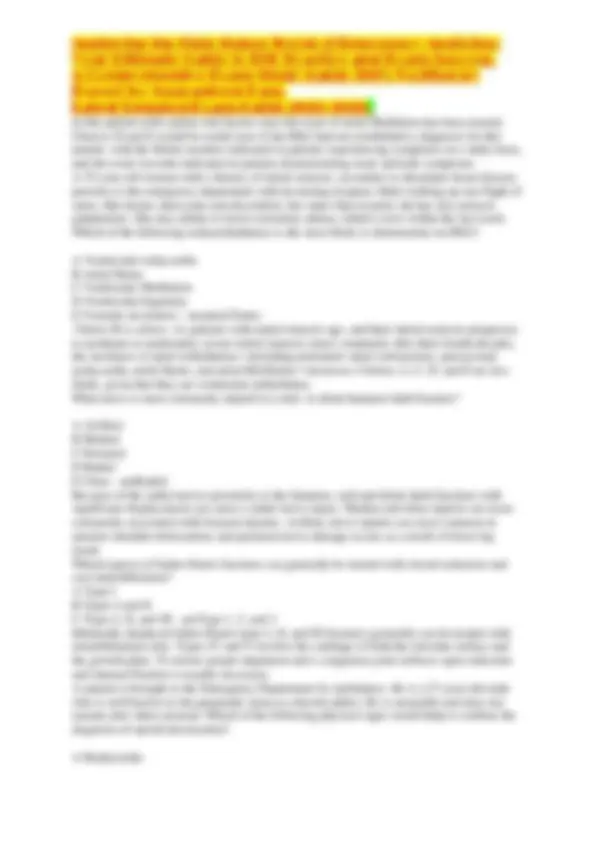
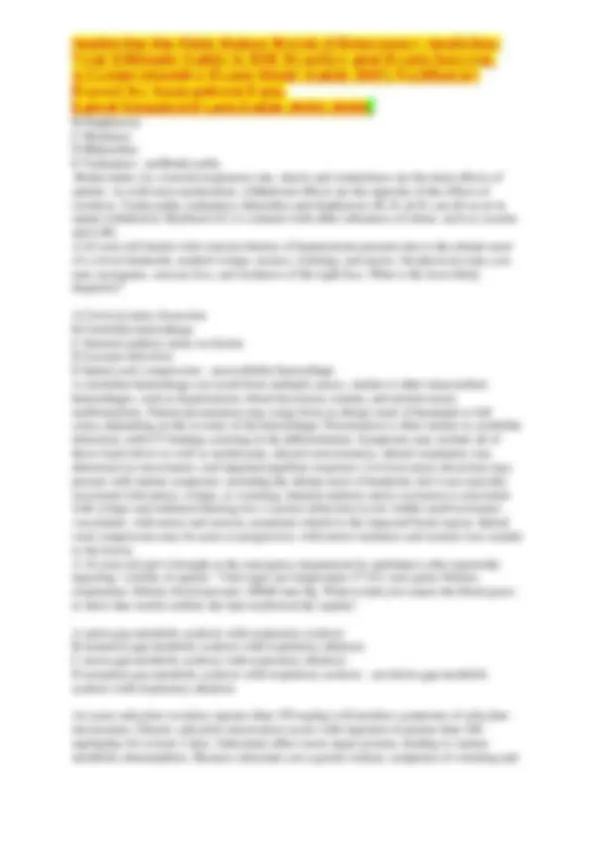
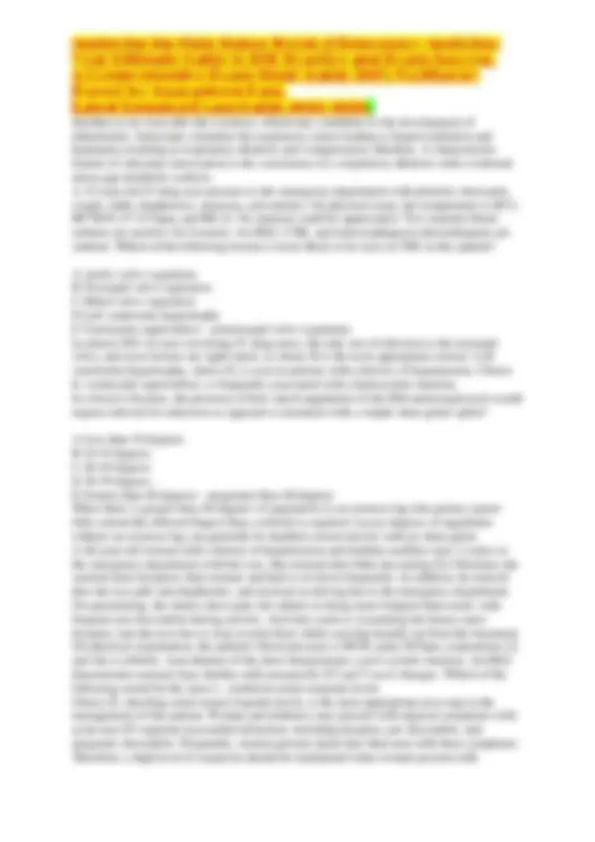
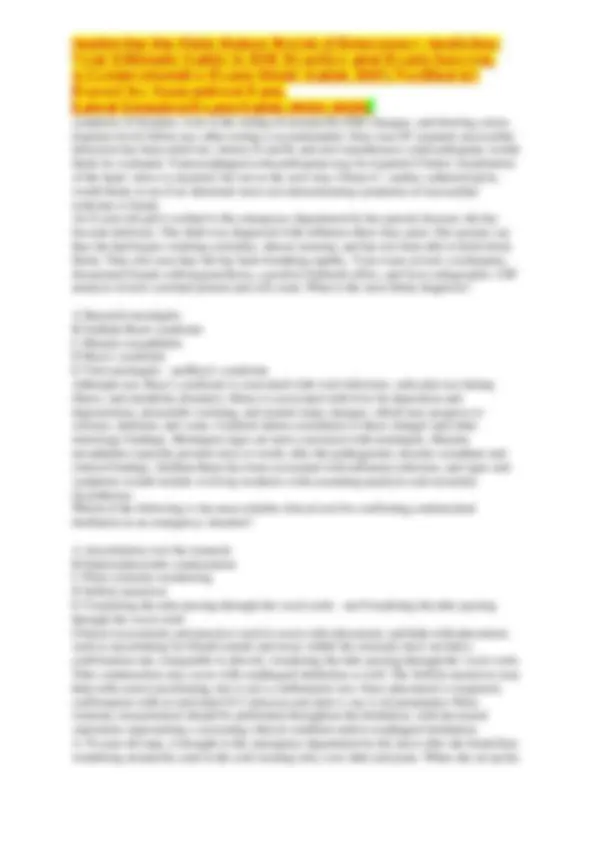
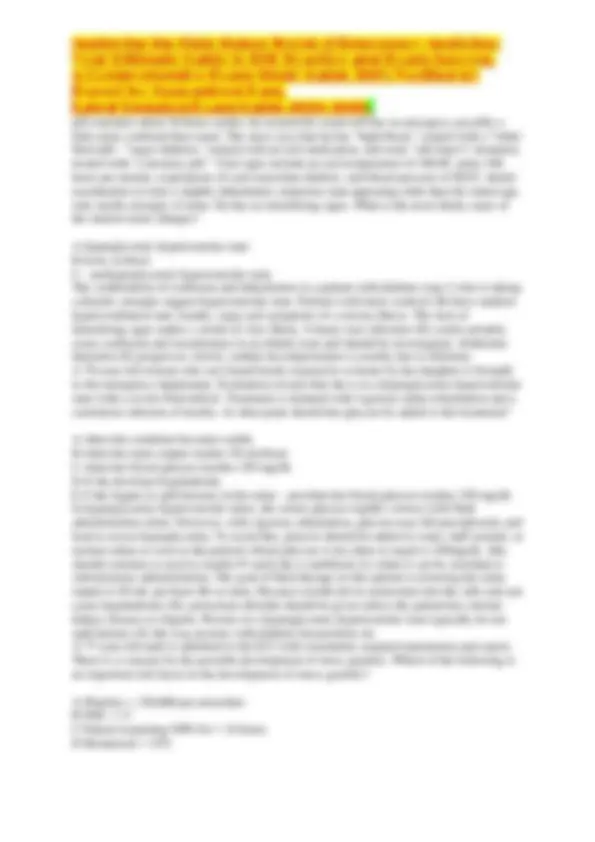
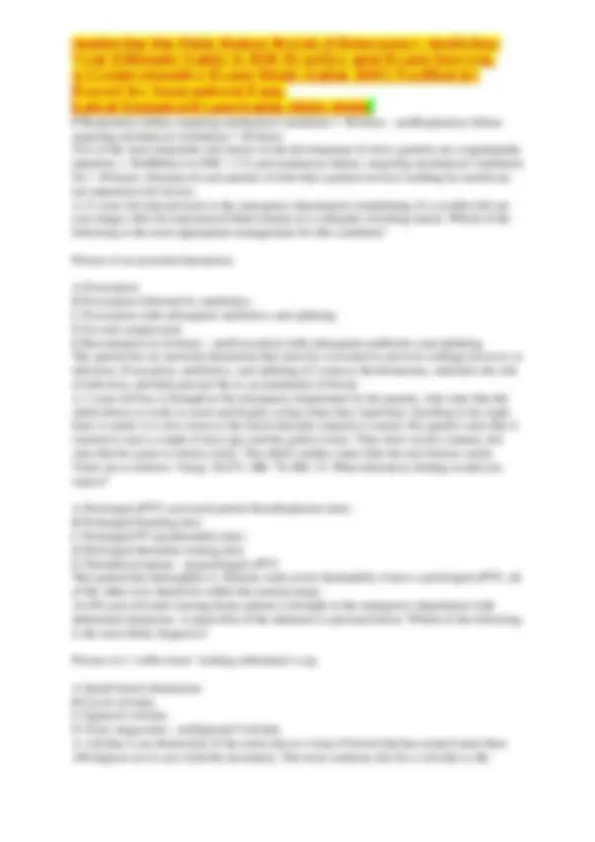
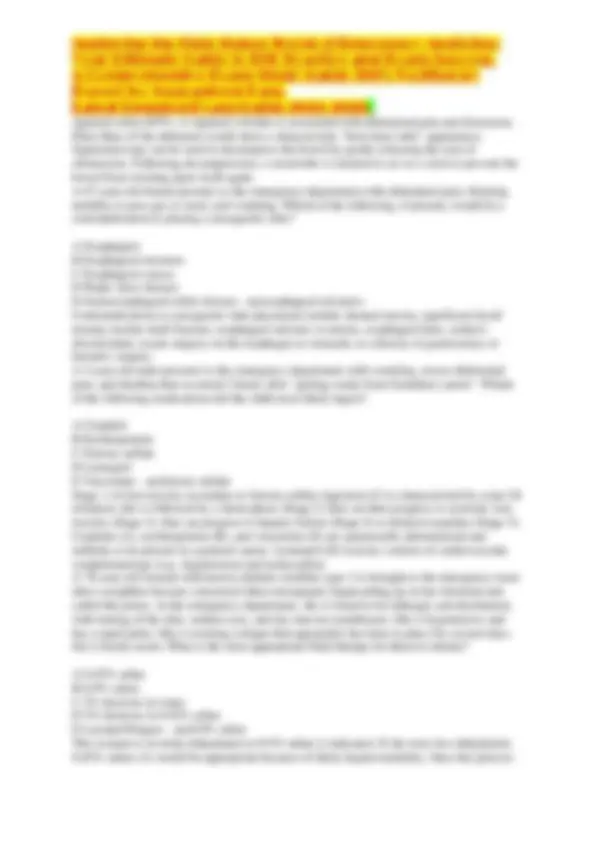
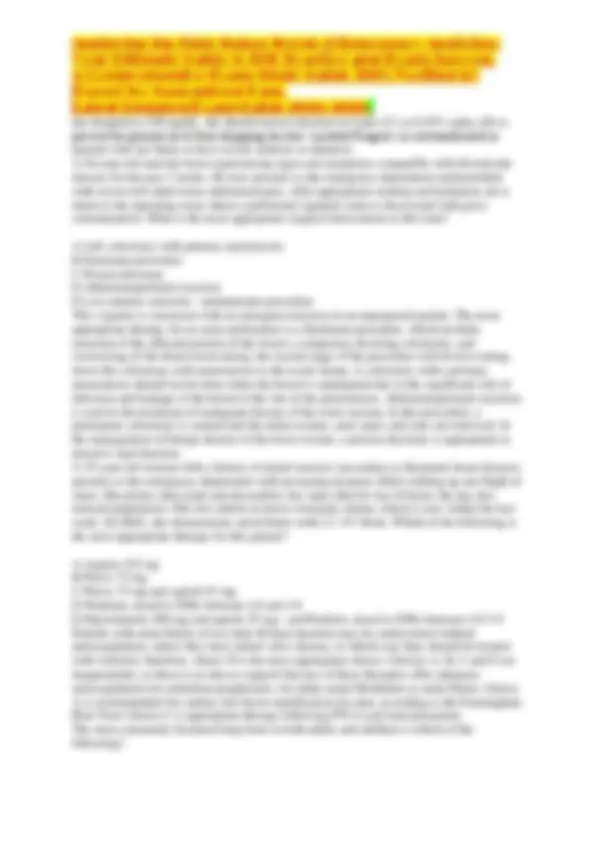
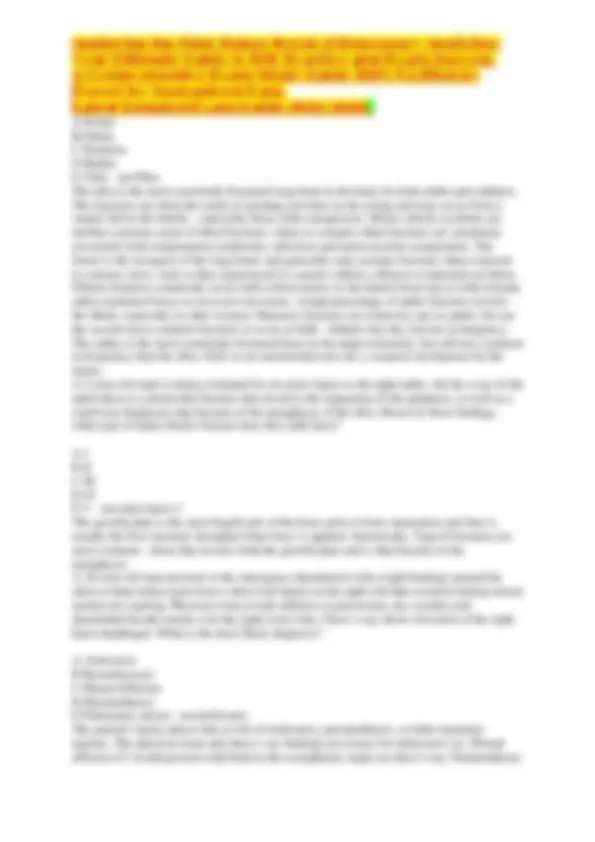
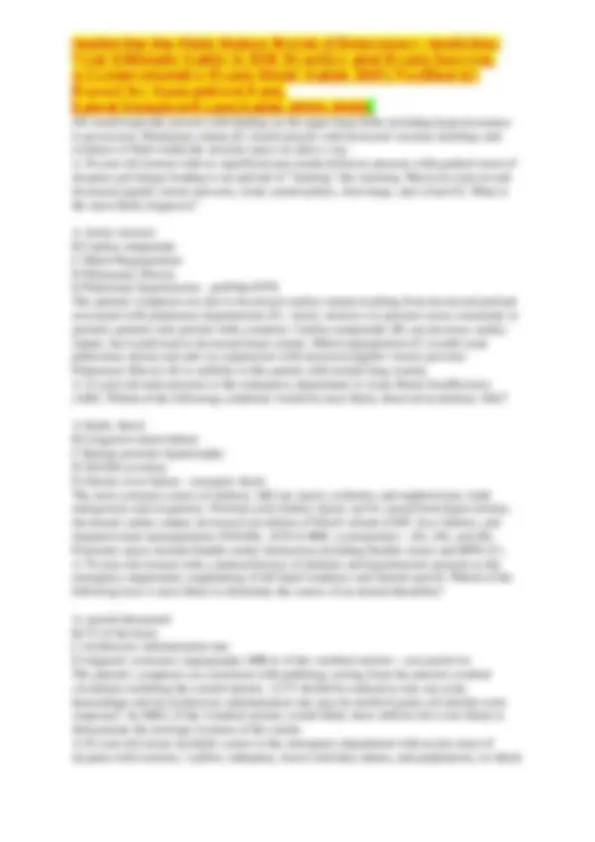
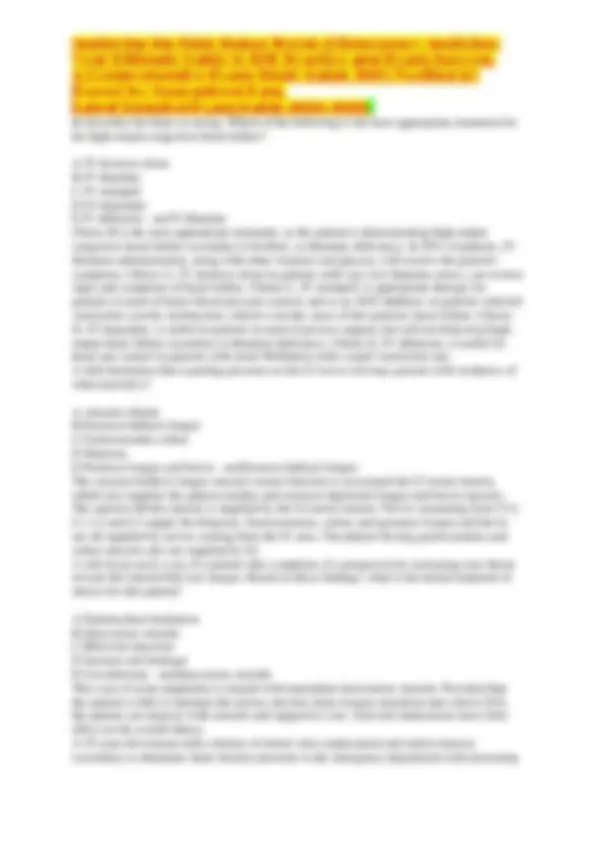
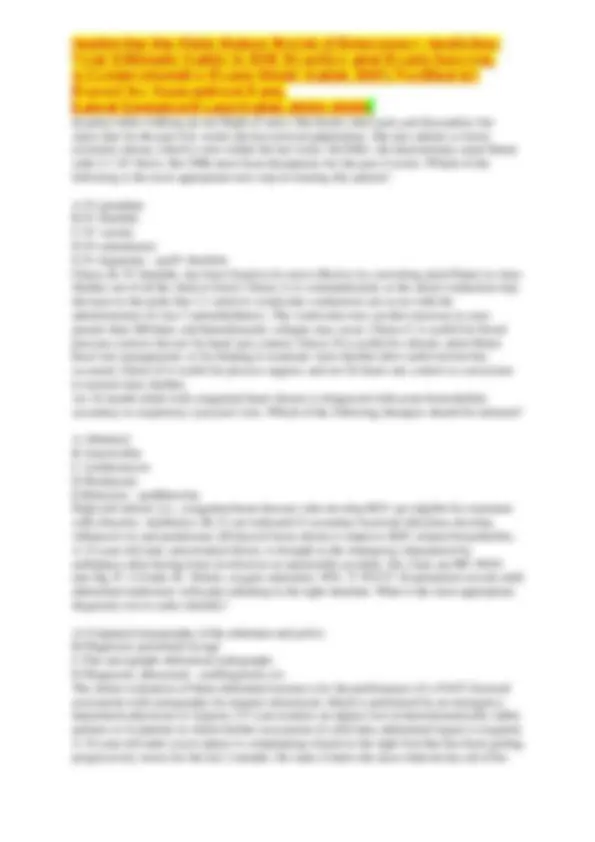

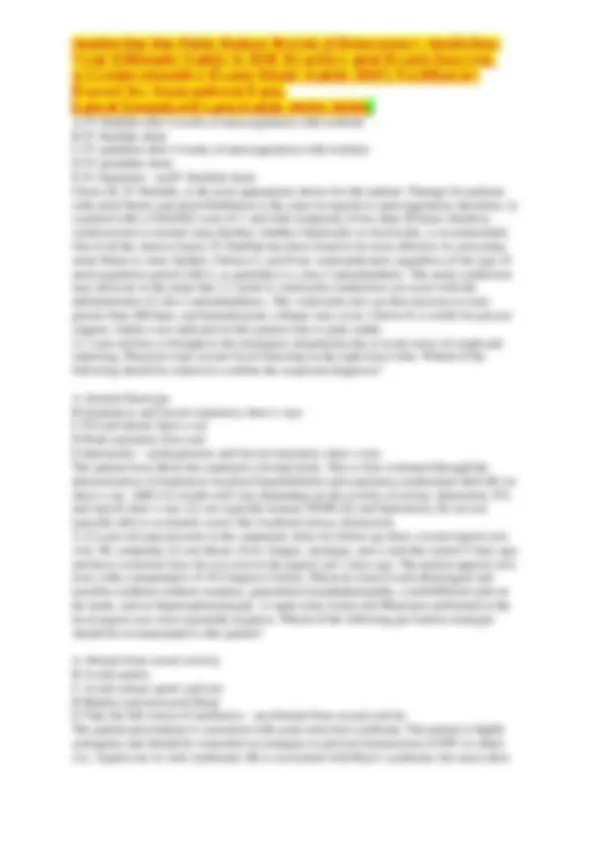
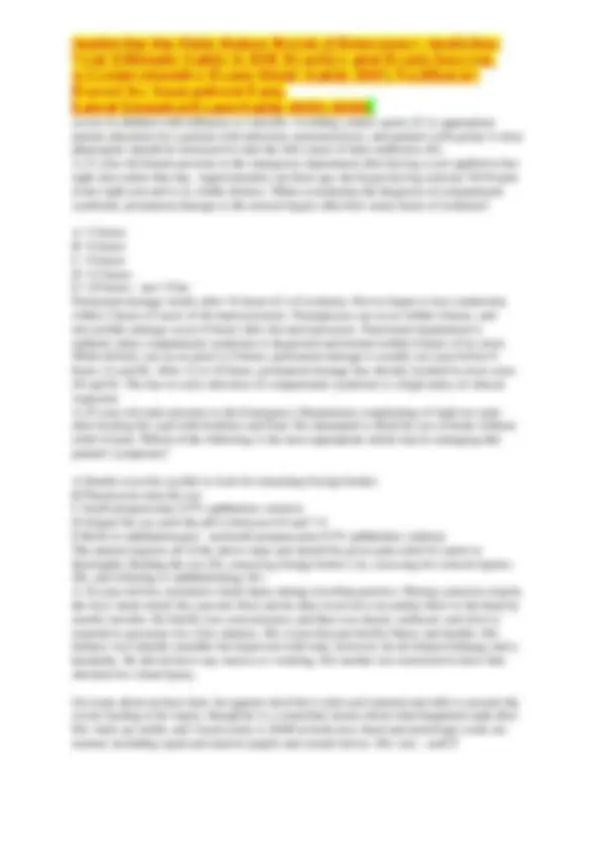
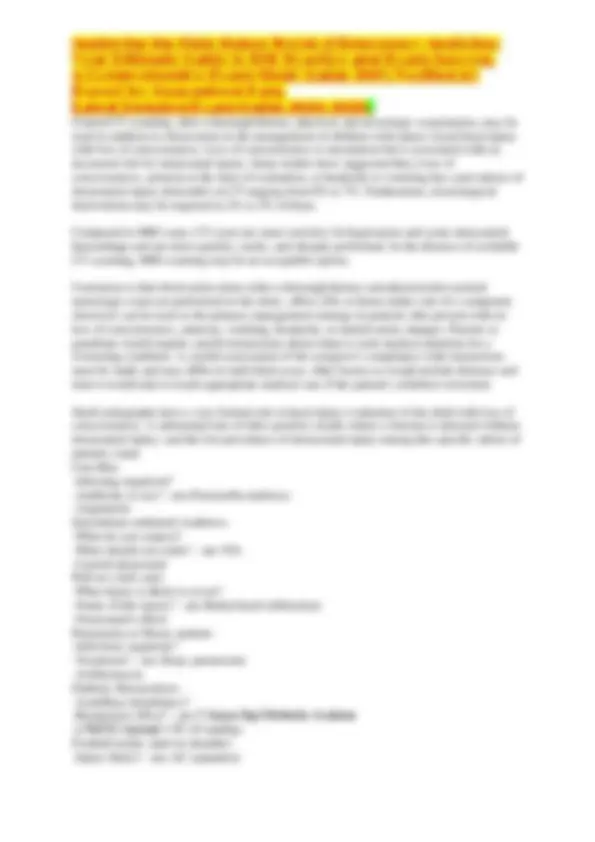





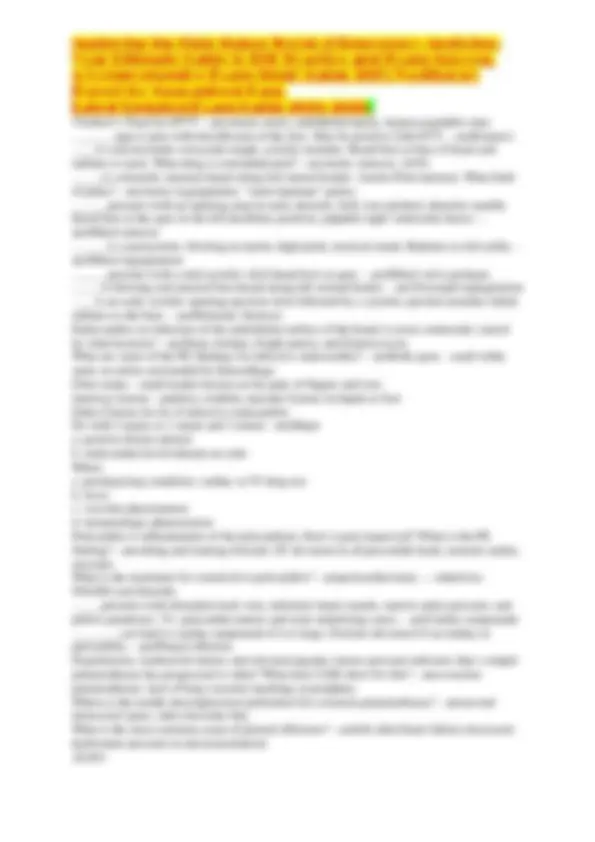

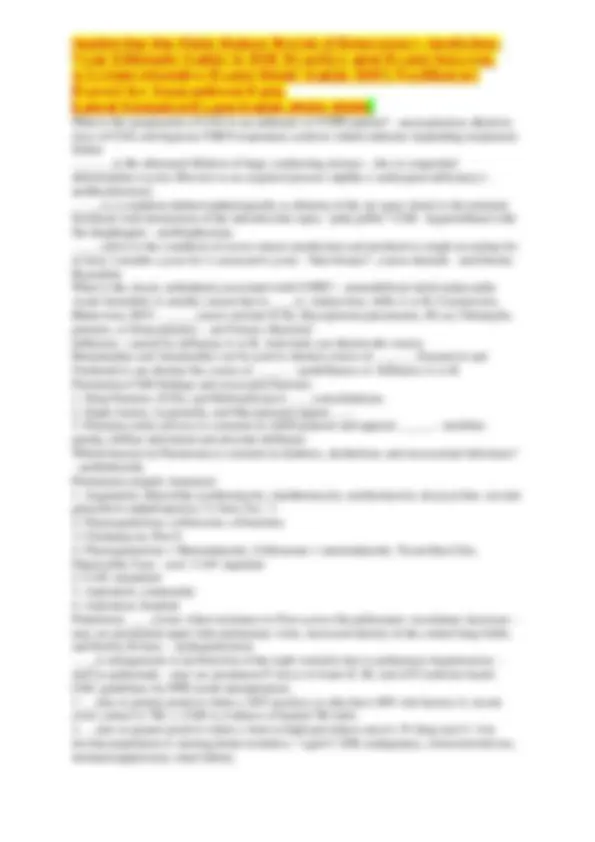
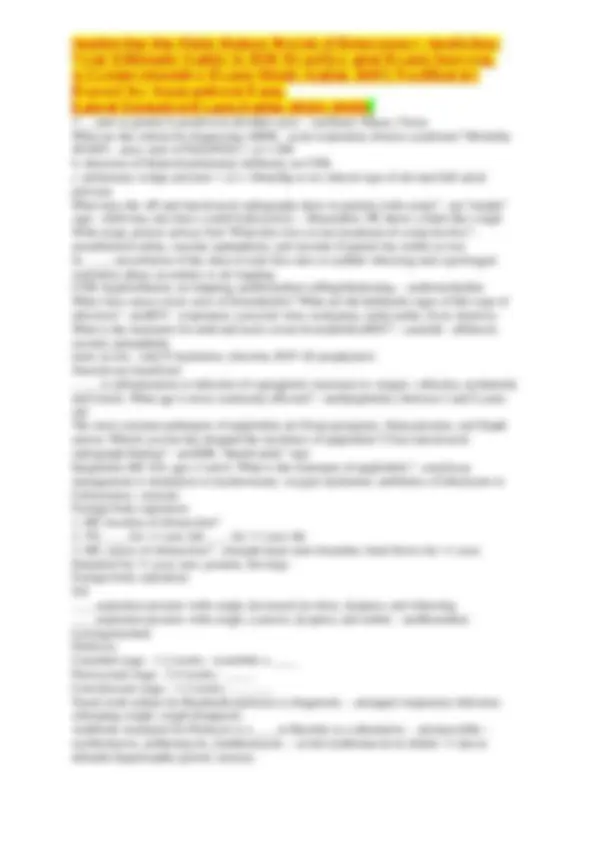




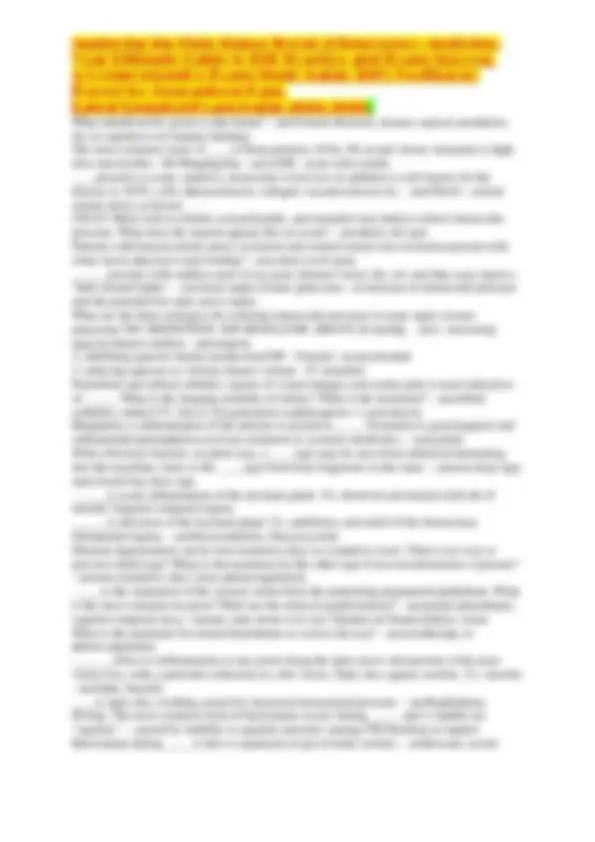




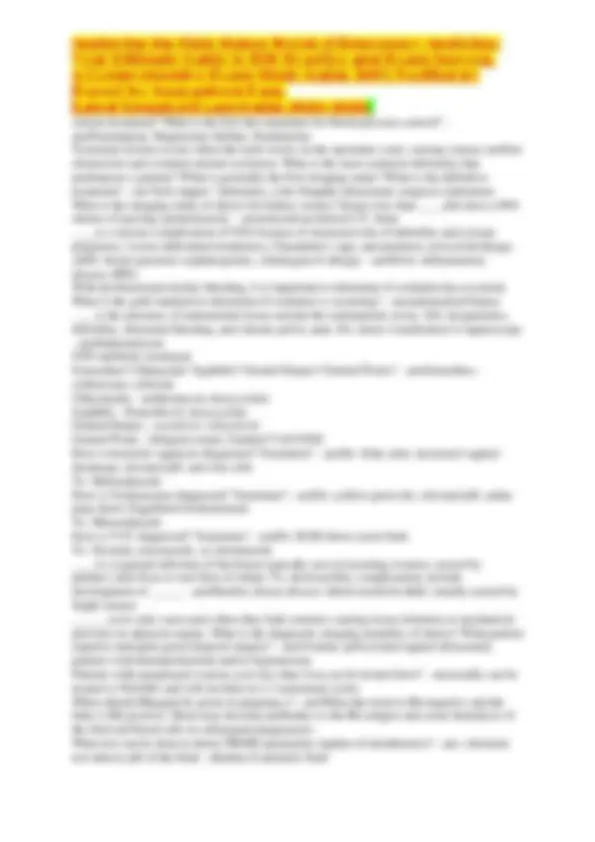

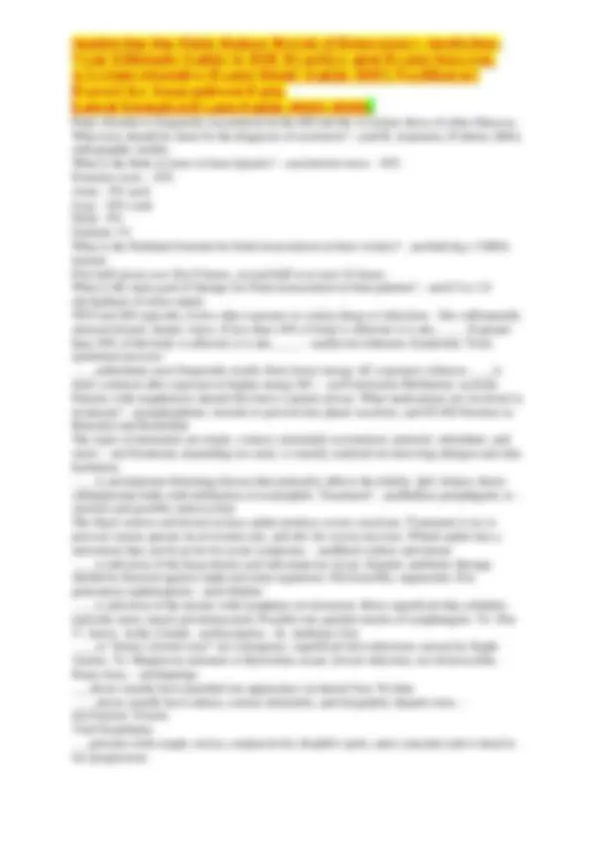



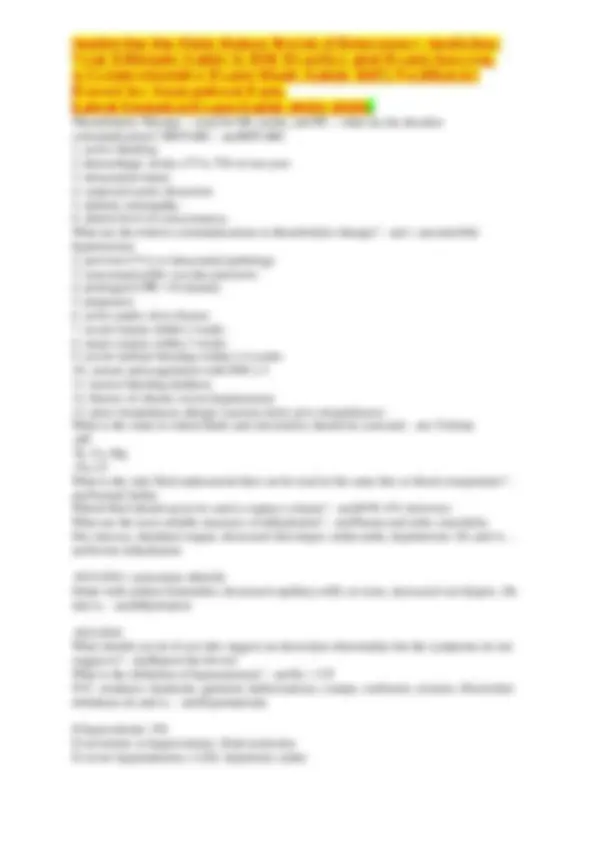
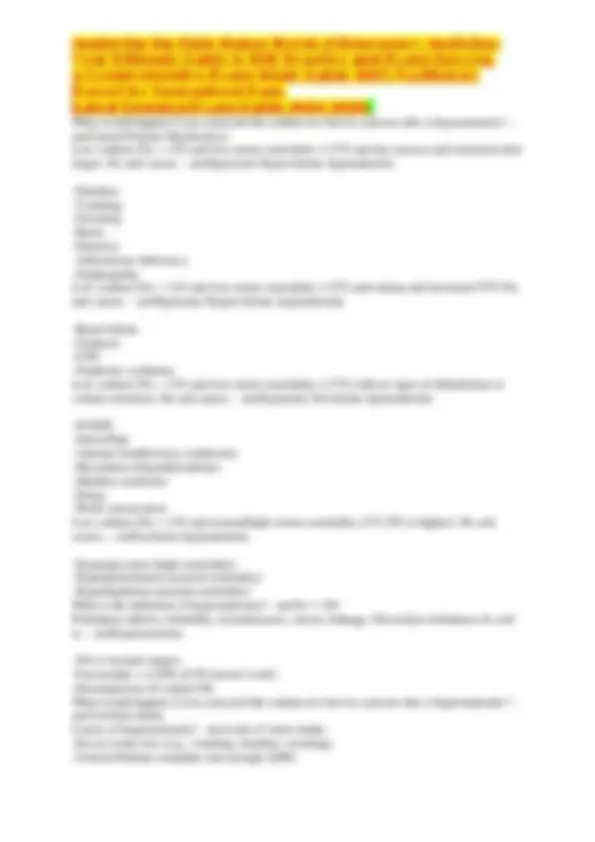
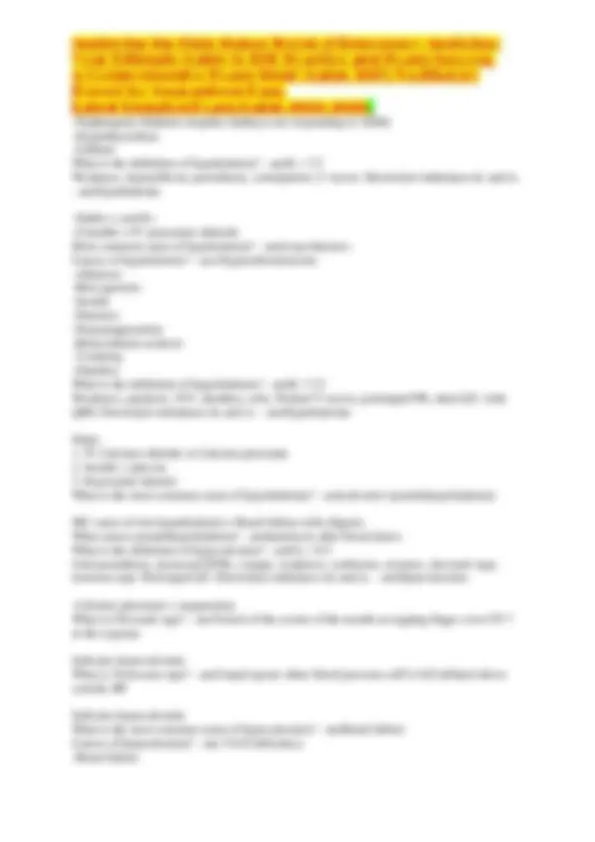
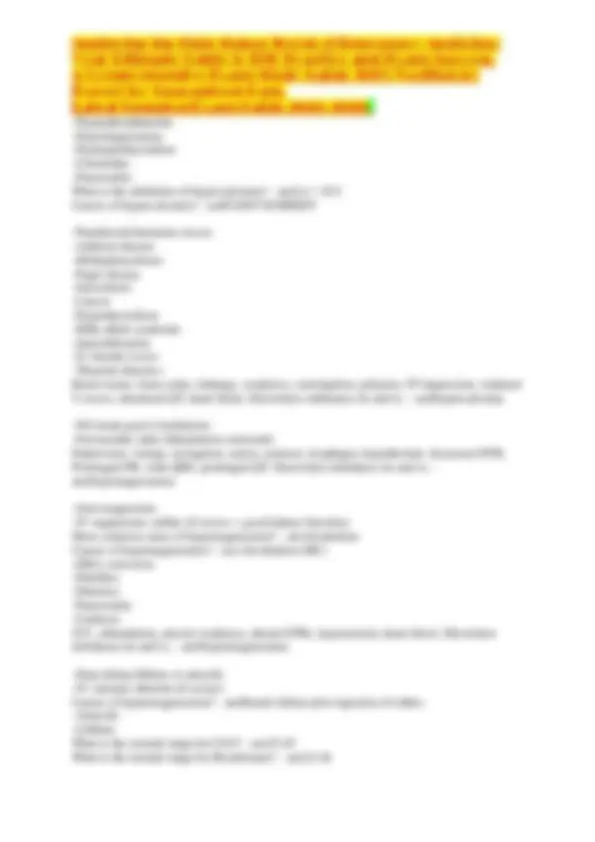


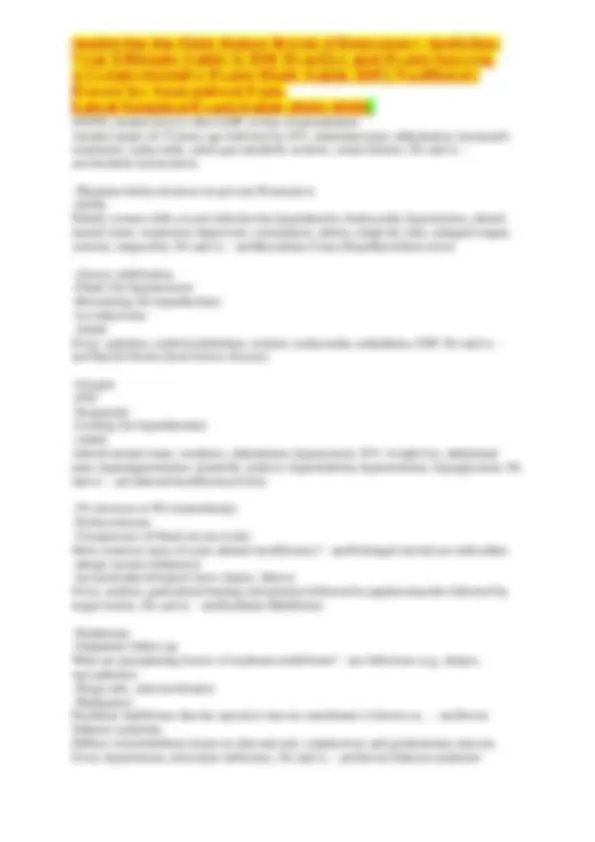
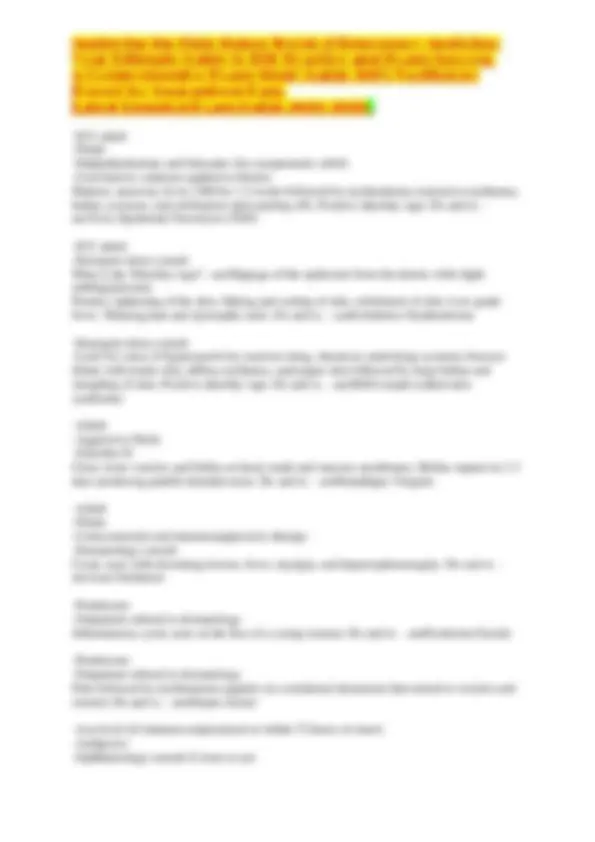
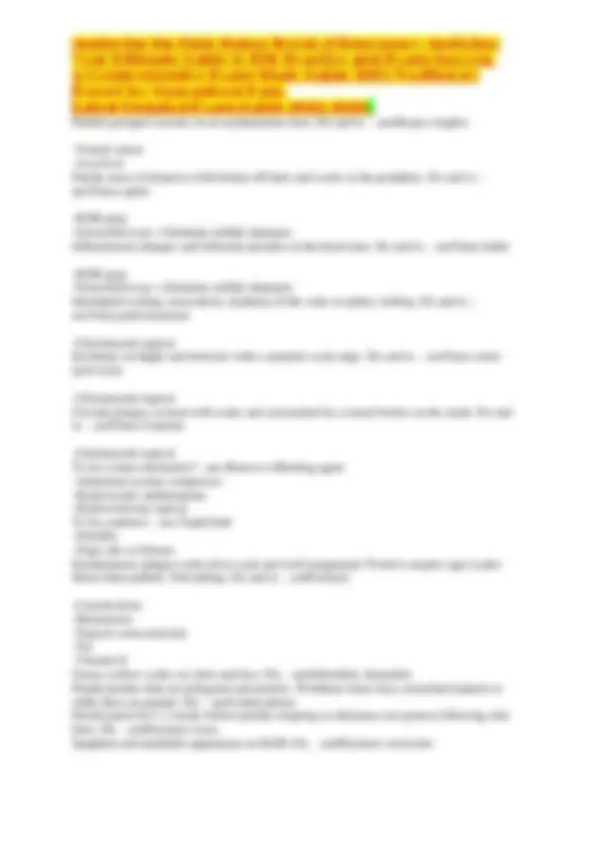
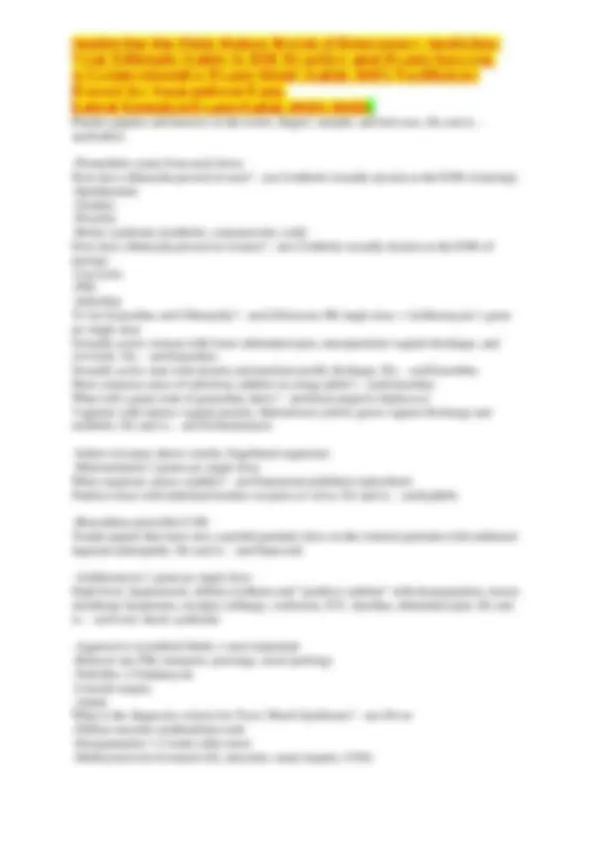
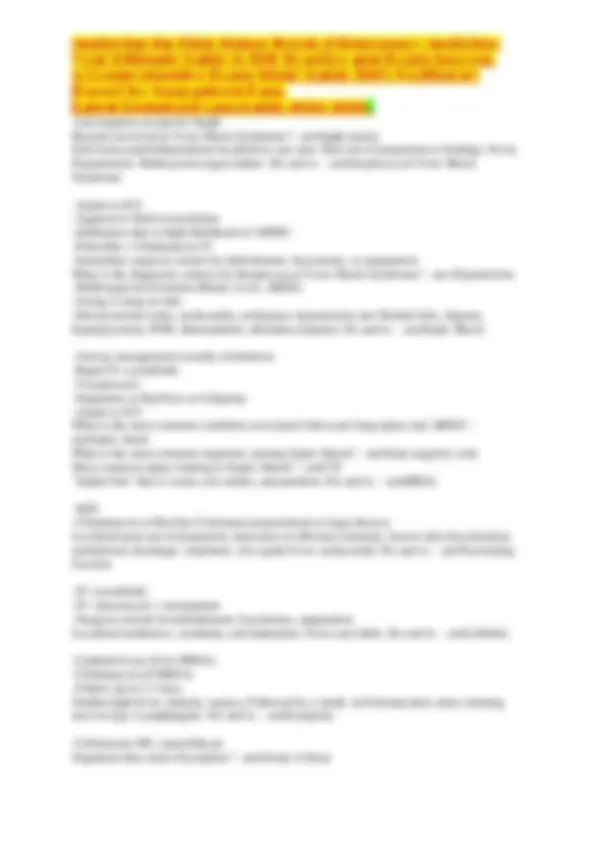


Study with the several resources on Docsity

Earn points by helping other students or get them with a premium plan


Prepare for your exams
Study with the several resources on Docsity

Earn points to download
Earn points by helping other students or get them with a premium plan
Community
Ask the community for help and clear up your study doubts
Discover the best universities in your country according to Docsity users
Free resources
Download our free guides on studying techniques, anxiety management strategies, and thesis advice from Docsity tutors
Mastering the High-Stakes World of Emergency Medicine: Your Ultimate Guide to EOR Practice and Exam Success. A Comprehensive Exam Study Guide 100% Verified by Expert for Guaranteed Pass. Latest Updated Exam Guide 2025/2026.
Typology: Exams
1 / 135

This page cannot be seen from the preview
Don't miss anything!





























































































A 59-year-old woman presents to the accident and emergency department by ambulance with second- and third-degree burns to her head and neck, and the anterior surfaces of her upper extremities, right leg, and trunk including her genital area. Question Which of the following represents a reasonable estimation of the extent of her burns? Answer Choices 1 36% 2 37% 3 46% 4 45% 5 55% - ansThe correct answer is 55%. This estimation is based on the "rule of 9s". Body surface area is estimated at 9% for each arm, the head and neck, anterior surface of upper torso, anterior surface of lower torso, posterior surface of upper torso, posterior surface of lower torso, anterior surfaces of each leg, posterior surfaces of each leg and an additional 1% for the groin area for a total of 100%. In this case, 9% for her head and neck, 9% for the anterior surface of each arm, 9% for the anterior surface of her right leg, 9% for her anterior upper torso, 9% for her anterior lower torso, and 1% for the genital area for a total of 55%. The other answers are incorrect using the estimation by the "rule of 9s". A 45-year-old man presents with hematemesis. He has had 2 episodes of vomiting 'coffee- ground'-appearing material; the vomiting began 45 minutes prior to presentation. Additionally, he reports passing black, sticky stools for the past 3 or 4 days. Past medical history is positive for occasional headaches; they have been coming more frequenly lately. Social history reveals alcohol use (1 case of beer each weekend) and tobacco (1 pack per day). Medications include ibuprofen as needed for headaches; he has been taking 800 mg 3 times a day for the past week. You place a nasogastric tube and find bright red blood that fails to clear with saline irrigation. Hemoglobin is 8.9 g/dL. Evaluation of his blood pressure and pulse reveals orthostatic changes that resolve with an intravenous fluid bolus of 500 cc of Lactated Ringer's solution. What should you do next? Answer Choices 1 Transfuse 2 units of packed red blood cells an - ansrefer for emergency endoscopy He should be referred for an emergency upper endoscopy. This patient is most likely bleeding from a gastric ulcer. His recent NSAID use, as well as his alcohol and tobacco habits, make him at risk for peptic ulcer disease. His symptoms of melena and hematemesis, along with his anemia, make the diagnosis quite straightforward. It appears that this patient is still actively bleeding based on the results of the nasogastric tube irrigation; therefore, the priority should be getting the ulcer to stop bleeding. Upper endoscopy should be performed so that the bleeding site can be identified and treated with electrocautery, coagulation, or injection of epinephrine or a sclerosing agent. If the bleeding cannot be stopped with endoscopic interventions, angiographic embolization should also be tried. If these interventions do not succeed, the patient has rapid deterioration, or if he
requires more than 6 units of blood in a 24-hour period, then emergency surgery may be indicated. The other choices are not the best options for immediate management. This individual cannot be followed simply with transfusions and serial CBC's because he appears to still be actively bleeding. Helicobacter pylori infection may very well be playing a part in the etiology of this man's ulcer, but evaluation for H. pylori can be done with a biopsy at the time of his endoscopy; it will not help in his immediate management. A barium esophagram will not identify actively bleeding ulcers and cannot treat active bleeding. While NSAID, alcohol, and tobacco use may have precipitated this man's GI bleed, counseling about his use of these substances will not sufficiently treat his immediate bleed. A 16-year-old male was hit on the left side of his face by a line drive baseball. Marked swelling is noted externally to the left eye. There was no loss of consciousness. Upon physical exam, he complains of diplopia during extraocular motion testing. Enophthalmos is noted, as well as decreased sensation of the left cheek. Plain x-rays of the face demonstrate an air-fluid level in the left maxillary sinus, and a fracture of the orbit. Based on this information, what is the most likely diagnosis? A Zygomatic arch fracture B Orbital blowout fracture C Le Fort I fracture D Le Fort II fracture E Le Fort III fracture - ansorbital blow out fracture B Diplopia is common in an orbital blow out fracture, due to entrapment of the inferior rectus and inferior oblique muscles. Loss of infraorbital sensation occurs from disruption or swelling of the infraorbital nerve. A Le Fort I fracture describes a transverse fracture separating the body of the maxilla from the pterygoid plate and nasal septum. A Le Fort II fracture describes a pyramidal through the central maxilla and hard palate. Movement of the hard palate and nose occurs, but not the eyes. A Le Fort III fracture describes a craniofacial disjunction, wherein the entire face is separated from the skull due to fractures of the frontozygomatic suture line, across the orbit and through the base of the nose, and ethmoids. The entire face shifts, with the globes held in place only by the optic nerve. What is the most common ECG abnormality in patients with a pulmonary embolism (PE)? A Atrial fibrillation B Sinus tachycardia C Ventricular ectopy D Sinus bradycardia - anssinus tachycardia B In most cases, sinus tachycardia is the only abnormality in patients with a PE. You may also find some ECGs that will have non-specific ST-T wave changes. Sinus bradycardia and AV blocks are not common findings that are associated with PE.
E C5 & C6 - ansC1 & C A Approximately 50% of cervical rotation takes place between the C1 (atlas) and C2 (axis) vertebrae. These first two cervical vertebrae have a different shape from the other cervical vertebrae that allow for this greater range of motion. The remaining 50 % of cervical rotation is split fairly evenly between the remaining vertebrae. Approximately 50 % of flexion and extension occurs between the occiput at the base of the skull and C1 with the remaining 50% distributed fairly evenly between the remaining vertebrae with a slightly higher percentage occurring at the C5 & C6 level. A 15-year-old boy suddenly collapses on the basketball court; his sports physical conducted at the beginning of the year did not elicit any abnormal findings. Basic life support initiated at the scene, however, is unsuccessful in resuscitation. Which of the following is the most likely etiology of his sudden death? A mitral valve prolapse B surgically corrected aortic stenosis C hypertrophic cardiomyopathy D rheumatic heart disease - anshypertrophic cardiomyopathy C Hypertrophic cardiomyopathy in adolescence is typically due to familial hypertrophic cardiomyopathy with an incidence of 1:500. Many patients are asymptomatic until a sporting event, which may cause symptoms, specifically sudden cardiac death. Examination may demonstrate a palpable or audible S 4 , an LV (left ventricular) heave, systolic ejection murmur (may need to stimulate cardiac activity), and/or a left precordial bulge. Echocardiography is the gold standard for diagnosis but family history should be assessed. Stress testing is indicated to assess for ischemia and arrhythmias. Strenuous activities are prohibited for these patients. The other cardiomyopathies (dilated and restrictive) are next but are not as common. Congenital structural abnormalities of the coronary arteries are the next most common cause. Valvular disorders, including surgically repaired aortic stenosis, are typically not causes of sudden death, but these patients should be screened for symptoms and stress tested as necessary. A 46-year-old female presents with pain to her left wrist. She complains that it is painful and swollen as she points to the volar aspect of the wrist on the radial side. On examination, there is a small, soft bump on the dorsum of her wrist with a jelly-like consistency. What is the most likely diagnosis? A Cancerous tumor B Fracture C Ganglion cyst D Hematoma E Lipoma - ansGanglion Cyst C Ganglion cysts commonly occur on the dorsal or volar aspect of the wrist. They result when a joint capsule or tendon sheath is damaged, allowing synovial fluid to escape producing a one-way valve, which allows fluid into the cyst, but not back out. The accumulating fluid forms the ganglion cyst. These cysts may or may not be tender and can fluctuate in size depending on activity level of the affected extremity. Cancerous tumors would tend to be much more firm, but also may be relatively pain free. Fractures would generally be exquisitely tender and if the bump is due to a displaced bone, it would be much
more firm than a ganglion cyst. Hematomas are generally associated with acute trauma and would be tender and ecchymotic in many situations. Lipomas are benign fatty tumors that are more commonly seen on the thenar eminence than the dorsum of the wrist and their size does not change based on activity level. A 65-year-old male presents with pain and swelling to his right knee without any history of injury. He has had this type of pain and swelling before, and does recall that he had fluid drained out of the knee several years ago. On examination the patient has a swollen, tender knee with a palpable effusion. There is decreased range of motion to the joint secondary to the effusion. An arthocentesis is performed, and the analysis of the fluid reveals calcium pyrophosphonate crystals. Based on these findings, what is the most likely diagnosis? A Septic arthritis B Acute synovitis C Hemarthoma D Pseudogout - ansPsuedogout D Pseudogout is also known as Calcium Pyrophosphate Deposition Disease (CPDD) and most commonly affects patients over the age of 65. The knee joint is most commonly affected with the wrist joint second most common. An examination of synovial fluid aspirated from the affect joints, will reveal calcium pyrophosphate crystal. Ankle joints are rarely affected by pseudogout but are fairly common locations for gout caused by urate crystal deposition. The first metatarsal phalangeal joint is the classic location for gout (sometimes referred to as podagra), but it is not a typical pseudogout location. The glenohumeral joint of the shoulder is affected by pseudogout much more than gout. Distal interphalangeal joints of the hand are rare locations for either gout or pseudogout, but are classic locations to see signs and symptoms of osteoarthritis. When pseudogout does affect the hands it is generally seen in the metacarpophalangeal joints. An 18-year-old woman is transferred to your emergency department from a local college infirmary. She presented yesterday with a complaint of headache but became confused and is now febrile. You notice a petechial rash on physical examination and her cerebrospinal fluid comes back with increased WBCs, increased protein, and decreased glucose. What is the most likely organism responsible for her meningitis? A Haemophilus influenzae B cytomegalovirus C Neisseria meningitidis D Mycobacterium tuberculosis E coxsackievirus B - ansNeisseria meningitis C Neisseria meningitidis and Streptococcus pneumoniae are the most common etiologic agents for bacterial meningitis in this patient's age group. So much so that many colleges and universities require a vaccine for students who live in dormitories. Her fever and the cerebrospinal fluid values are consistent with a bacterial and not a viral infectious source for the meningeal irritation. A 24-year-old HIV-positive man comes to the emergency department complaining of severe left-sided chest discomfort, which radiates through to the left trapezius region. On coming into the room, you note that he is sitting up and hunched forward. On physical examination, the patient's blood pressure is 135/78, with a pulse of 85 bpm, and a pericardial friction rub is noted. Laboratory findings demonstrate elevated serum creatine kinase levels and normal
respiratory rate per age, decreased oral intake or feeding difficulty with associated decreased oxygen saturation, decreased oxygen saturation with varying ranges based on source (most being <95%), a history of previous intubation, and a caregiver ability to adequately provide care and monitoring. What is the most common pathogen that causes an acute bronchitis? A Viral B Bacterial C Fungal D Unknown - ansviral A Respiratory viruses are the most common cause of acute bronchitis. In clinical medicine, it is rare to obtain cultures for patients who present with bronchitis symptoms. A 40- year-old female patient comes to the office because she notices that she is easily fatigued but cannot pinpoint a direct cause of her fatigue. She has experienced muscle tenderness to the shoulders and other large muscle groups, sensitivity to touch these areas, and has also felt depressed lately. Based on this history and the vague physical exam findings, what is the most likely diagnosis? A Fibromyalgia B Polyarteritis nodosa C Polymyositis D Scleroderma - ansFibromyalgia A Fibromyalgia syndrome (FMS) primarily affects woman between the ages of 20 and 60 and is now the second most common condition seen in rheumatologists' offices behind only rheumatoid arthritis. This condition spares the joints, but causes tender areas throughout the soft tissue as well as generalized pain and fatigue. There are several common trigger points, both anteriorly and posteriorly that help confirm the diagnosis. Polyarteritis nodosa is a systemic necrotizing vasculitis that generally affects medium size muscular arteries. Patients can present with many of the same symptoms as those with fibromyalgia (fatigue, muscle pain, and others), but these patients often have skin manifestations, joint pain, and fever, along with renal, GI, and cardiovascular signs not seen in fibromyalgia. Polymyositis is an inflammatory condition of the muscles that is characterized by proximal muscle weakness, with much less pain than is seen in fibromyalgia. Despite the proximal muscle weakness there is generally not significant atrophy. Sjogren's syndrome does not generally present with any muscular manifestations. It is a chronic inflammatory disorder that affects the salivary and lacrimal glands resulting in dry eyes and a dry mouth. Scleroderma is classically associated with thickened and hardened skin, but it can have internal organ involvement as well affecting many different body systems. When it affects the musculoskeletal system it tends to affect joints and the areas where tendons cross joints. It can cause contractures, pain, and swelling as well as fatigue and weakness A 76-year-old male presents to the hospital with a hot, swollen, and painful right knee that appears to have an effusion. After your examination, you decide to perform an arthrocentesis. The fluid aspirate is turbid, cloudy, and most definitely looks like it is infectious material. Based on this clinical scenario, what would be most likely bacterial organism present in an elderly septic arthritis? A Hemophilus influenzae
B Neisseria gonorrhoeae C Pseudomonas aeruginosa D Staphylococcus aureus - ansstaph aureus D Septic arthritis is an infection within a joint space. The infection can be caused by multiple pathogens including bacteria, viruses, fungi and mycobacteria, but in older adults the most common organism implicated is Staphylococcus aureus. These bacteria can get into the joint space through multiple mechanisms including direct inoculation after a penetrating injury, hematogenous spread from an infection elsewhere in the body, or from extension from a contiguous bone infection. All of the bacteria mentioned as possible answers are possible causes of septic arthritis, but there prevalence varies within different patient populations. Hemophilus influenza and Streptococcus pneumonia are commonly seen in children less than five years of age that develop septic arthritis. Neisseria gonorrhoeae is most common in sexually active adolescents and young adults. Pseudomonas aeruginosa is a common cause of septic arthritis in IV drug abusers You are evaluating a 72-year-old male who is referred to the emergency department from his primary care office. On examination you note a lethargic obese male with the following vitals: BP of 225/135 a P of 88, and T of 98.4˚F. He reports discontinuing all his medications for blood pressure 6 months ago due to financial reasons. Which of the following physical examination findings would be most consistent with a diagnosis of a hypertensive emergency? A normal exam B xanthelasma C varicose veins D papilledema - anspapilledema D The correct answer is (D). This patient has significantly elevated blood pressure, lethargy, and evidence of hypertensive encephalopathy, which is supported by a physical examination finding of papilledema. Additional workup may be indicated to rule out other causes of his papilledema. Target organ damage is apparent in anyone with hypertensive emergencies and may be neurological, renovascular, cardiovascular, or a combination thereof. Prompt treatment is necessary to prevent complications. Although the physical examination may be normal, evidence of end-organ damage is likely on examination and/or laboratory/diagnostic studies. Choices (B), (C), (E) are not representative of end-organ damage seen in hypertensive emergencies. A 27-year-old African American female presents to the emergency department with low blood pressure of 100/40, palpitations, and shortness of breath. She is currently under treatment for Wolff-Parkinson-White syndrome and has been taking procainamide for the last two years. An electrocardiogram is obtained on the monitor and reveals the rhythm strip shown. What is the treatment of choice for this patient? EKG shows tosades de pointe A Intravenous calcium B Intravenous magnesium C Oral potassium D Subcutaneous epinephrine E Metoprolol - ansIV Mg
wear and tear after many years or the process can be accelerated after a significant acute trauma to a joint. Neither scenario is applicable to this patient. Which of the following is a type of primary malignant tumor of the bone? A Enchondroma B Leiomyoma C Lipoma D Melanoma E Osteosarcoma - ansosteosarcoma E Osteosarcoma is a type of primary bone cancer. Fortunately this is a rare cancer, accounting for only 1% of the cancers diagnosed each year in the USA for patients of all ages. Osteosarcomas are more common in the pediatric population, accounting for 5% of all childhood cancers and 56% of all cancers of the bone in patients less than 20 years old. Osteosarcomas have a bimodal occurrence rate with the highest prevalence between ages 11- 13 and over the age of 65. Enchondromas are common benign cartilaginous tumors that develop in the medulla (marrow cavity) of bone. A leiomyoma is another name for a benign uterine fibroid. A lipoma is a benign, soft, freely movable, generally nontender mass in the soft tissue sometimes referred to as a fatty tumor. These are generally inconsequential, but may be a marker for spina bifida if found in the lumbar region. Melanoma can be found in bone, but it would be considered a metastatic lesion and not a primary malignant bone tumor. A 66-year-old male with a history of hypertension, diabetes mellitus, and hypercholesterolemia presents by emergency medical services (EMS) to the emergency department complaining of severe chest pain with radiation into his back. The patient states that he was feeling well in the morning, but while performing some light activity he felt a "ripping" sensation in his back, which he initially thought was a pulled muscle. The pain continued and the patient started to have chest pain, shortness of breath, and lightheadedness. On initial examination the patient is still in pain, pale, diaphoretic, and has a blood pressure of 85/40. His chest is clear to auscultation, and he has a 3/6 diastolic murmur best appreciated at the base of the heart. Given this clinical scenario, what is the most likely diagnosis? A Pneumothorax B Dissecting thoracic aneurysm C Acute myocardial infarction D Pulmonary embolus - ansdissecting thoracic aneurysm B This patient is exhibiting a history and physical examination that is consistent with a thoracic aneurysm. The patient's history of hypertension, along with the "ripping" sensation in his back and hypotension give a clinical presentation that is suggestive of a thoracic aneurysm dissection (B). A pneumothorax (A) would have more pleuritic characteristics, and chest pains without the ripping sensation or loud diastolic murmur would be more likely in a situation of myocardial infarction (C). Pulmonary embolus (D) and esophageal perforation (E) would typically not present with the above complaints or physical exam findings. A 55-year-old right-hand dominant man presents with a 4-hour history of weakness and tingling of his right hand and numbness of the right side of his mouth. Mild difficulty was noted with word finding. His symptoms have improved since onset but have not fully resolved. There is no significant medical history. Physical examination revealed flat right nasolabial fold, subjective numbness of the right hand, right pronator drift, clumsiness of
finger tapping on the right hand, increased deep tendon reflexes on the right, as well as a present Babinski. What is the most likely etiology for this patient's problem? A migraine headache B peripheral neuropathy C syncope D transient ischemic attack E seizure - ansTIA D Three key features of a transient ischemic attack include sudden onset and complete reversal of symptoms within 24 hours, usually within 15 minutes. The symptoms are usually in the anatomical distribution of a single blood vessel. This patient's history is not suggestive of migraine or syncope. His physical examination findings do not correlate with peripheral neuropathy or seizure. A 25-year-old male has a history of schizophrenia, and was brought to the emergency department by ambulance after he was found wandering along the highway. Which of the following is considered a positive symptom of schizophrenia? A Catatonia B Diminished sociability C Hallucinations D Poverty of speech E Restricted affect - anshallucinations C Hallucinations, delusions, and formal thought disorders are classified as positive symptoms of schizophrenia. Negative symptoms of schizophrenia include restricted affect, diminished sociability, and poverty of speech. Catatonia describes a state in which a person is withdrawn and shows minimal bodily movement, or one in which there is severe excitement and the person shows purposeless and stereotyped movements. A 66-year-old male with a history of hypertension, diabetes mellitus, and hypercholesterolemia presents by emergency medical services (EMS) to the emergency department complaining of severe chest pain with radiation into his back. The patient states that he was feeling well in the morning, but while performing some light activity he felt a "ripping" sensation in his back, which he initially thought was a pulled muscle. The pain continued and the patient started to have chest pain, shortness of breath, and lightheadedness. On initial examination the patient is still in pain, pale, diaphoretic, and has a blood pressure of 85/40. His chest is clear to auscultation, and he has a 3/6 diastolic murmur best appreciated at the base of the heart. Given this clinical scenario, what would be the expected finding on chest x-ray? A Normal B Pleural effusion C Decreased lung volume D Widened mediastinum E Cardiomegaly - answidened mediastinum A 19 year-old-male is brought to the emergency department due to psychosis. During the evaluation, he is noted to appear unkempt and has reduced motor activity. His affect is flattened, and he is using made-up words and phrases during speech. This patient is exhibiting what type of verbal utterance?
likely in a patient with these EKG changes. Choice D, aortic dissection, would present with chest pain; however, the patient would be markedly hypotensive, less stable on presentation, and a CXR would demonstrate widening of the superior mediastinum Which physical complaint is the leading cause of lost work time and disability for patients under the age of 45? A Ankle pain B Hip pain C Knee pain D Low back pain E Shoulder pain - ansLow back pain D Low back pain is the most common causes of lost time from work and disability. Factors that can lead to back problems include repeated or heavy lifting and twisting or use of vibrating equipment along with poor fitness levels, smoking, poor job satisfaction and other psychosocial factors. Fortunately, 80% of patients experience significant recovery within one month. All of the other types of pain can occur based on multiple factors, but none of them occur with a frequency that rivals low back pain A 24-year-old HIV-positive man comes to the emergency department complaining of severe left-sided chest discomfort, which radiates through to the left trapezius region. On coming into the room, you note that he is sitting up and hunched forward. On physical examination, the patient's blood pressure is 135/78, with a pulse of 85 bpm, and a pericardial friction rub is noted. Laboratory findings demonstrate elevated serum creatine kinase levels and normal serial troponin levels. His EKG demonstrates peaked T waves. His CXR demonstrates a "water bottle" cardiac silhouette. Which of the following are serious consequences of acute pericarditis, which require careful monitoring? A Pericardial effusion B Aortic dissection C Myxedema D Chylopericardium E Acute myocardial infarction - anspericardial effusion A Choice A, pericardial effusion, is a serious consequence of acute pericarditis, which requires careful monitoring to ensure that progression of the pericardial effusion does not lead to cardiac tamponade, which can be fatal if not treated promptly. Choice B is unlikely in a patient with acute pericarditis. Choices C, D, and E are noninfectious causes, not consequences of pericarditis. A 53-year-old man presents to the emergency department because of fever, headache, and confusion. On physical examination, you note an obtunded man who appears acutely ill with temperature of 104°F, blood pressure of 128/76 mm Hg, pulse of 98, and respiratory rate of
D serum IgG for herpes simplex virus E MRI of the head - anspolymerase chain reaction test for herpes simplex virus B The patient's presentation is consistent with viral meningitis with potential encephalitis. The presence of active stomatitis indicates herpes simplex virus as the most likely causative organism. A CT of the head could be considered prior to performing a lumbar puncture and may show temporal lobe abnormalities that support a diagnosis of herpes virus encephalitis, but like an MRI will not identify the causative organism and has limited sensitivity. Of the three herpes tests described, the PCR technique is the most likely to identify the herpes simplex virus as the causative organism in the CSF due to its high sensitivity and specificity. Serum IgG indicates prior infection from herpes simplex virus but does not confirm the causative organism of the patient's encephalitis. Viral blood cultures for herpes simplex would likely show no growth even in the presence of herpes simplex virus encephalitis A 48-year-old man presents to the emergency department with acute right upper quadrant tenderness, fever, and mild jaundice. Which of the following is most likely to be elevated in the blood? A bilirubin B creatinine C glucose D ketones E uric acid - ansbilirubin A This patient's signs and symptoms correlate with a suspected case of cholecystitis. Jaundice is associated with hyperbilirubinemia, in which the excess bilirubin can deposit in tissues such as the skin, sclera, and nails, causing a yellowish discoloration. Bilirubin is the waste product generated from the metabolism of hemoglobin. A 21-year-old male presents to the emergency department due to vomiting blood. He is a college student and was initiated into a fraternity earlier in the week, and admits to drinking enough alcohol to make him vomit that night. There was no blood in the vomit at that time. The hematemesis started today, about 20 minutes after he finished a workout at the gym. He notes that today was a particularly tough workout, as he increased the amount of weight he was lifting significantly compared to previous workouts. His vital signs are as follows: heart rate 86 bpm, respirations 14, BP 126/82, temp 98.8°F. What is his most likely diagnosis? A Mallory-Weiss syndrome B Peptic ulcer disease C Arteriovenous malformation D Esophageal varices E Erosive gastritis - ansmallory weiss syndrome A The correct answer is Mallory-Weiss syndrome. This is characterized by a nonpenetrating mucosal tear at the gastroesophageal junction, which may arise from a sudden increase in transabdominal pressure, such as lifting, retching, or vomiting. Peptic ulcer disease usually presents with a history of dyspepsia. Arteriovenous malformations usually present with melena or hematochezia. Esophageal varices usually develop secondary to portal hypertension, and are most often found in patients with cirrhosis. Erosive gastritis is often due to NSAIDs, alcohol, or severe medical or surgical illness, and is more often associated with chronic blood loss.
B Aortic regurgitation/insufficiency C Mitral stenosis D Aortic regurgitation/insufficiency E Tricuspid regurgitation/insufficiency - ansA Choice A is correct, as the murmur of aortic stenosis is usually described as a crescendo-decrescendo or systolic ejection murmur heard best at the right upper sternal border. In addition, the murmur of aortic stenosis is frequently transmitted to the carotid arteries. In a patient of this age, with symptoms suggestive of severe aortic stenosis and with these physical exam findings, a congenital bicuspid aortic valve is the best choice, especially as the patient denies a history or rheumatic fever, which is also a cause of developing aortic valve stenosis in individuals under the age of 65. Patients with a congenital bicuspid aortic valve typically develop symptoms once the valve leaflets have become calcified and thickened, secondary to the undue stress over many years on a structurally abnormal aortic valve. Choice B is incorrect, as the murmur of aortic regurgitation is usually described as a high-frequency decrescendo early diastolic murmur heard best at the left upper sternal border or at the right upper sternal border. Choice C is incorrect, as the murmur of mitral stenosis is described as a low-frequency rumbling diastolic murmur that is decrescendo in early diastole, but may become crescendo up to the first heart sound with moderately severe mitral stenosis and sinus rhythm. Choice E is incorrect, as the murmur of tricuspid regurgitation is described as a holosystolic descrescendo murmur. What type of fracture is not related to an acute bony trauma? A Greenstick B Stress C Oblique D Comminuted E Spiral - ansStress B A stress or fatigue fracture is caused by small, repetitive forces that usually involve the metatarsal shafts, the distal tibia, and the femoral neck (though many other bones may be affected). These fractures may not be seen on initial radiographs. A greenstick fracture is an incomplete traumatic fracture with angular deformity seen in children. An oblique fracture is a traumatic fracture with an angulated fracture line. A comminuted fracture is a traumatic fracture in which there are more than two fracture segments. A spiral fracture is a traumatic fracture that has a multiplanar and complex fracture line usually caused by an excessive rotational force on a bone. Active elbow extension is primarily controlled by which muscle(s)? A Anconeus B Biceps C Brachialis D Brachioradialis E Triceps - ansTriceps E The triceps are the primary muscles that produce active elbow extension. The anconeus muscle is known as a secondary elbow extensor. The biceps and brachialis muscles are primary muscles of elbow flexion and the brachioradialis is a secondary elbow flexor. A 55-year-old woman with a history of emphysema, who is undergoing chemotherapy for lung cancer, comes to the emergency department complaining of a sudden increase in dyspnea, with exertion and fatigue. On physical exam, hypotension, pulsus paradoxus, and
muffled heart sounds are noted. On transthoracic echocardiography, cardiac tamponade is noted, with over 200 mL of pericardial fluid described. Which of the following would be this patient's most likely electrocardiographic finding (Figure 7)? A Torsades de pointes B U waves C Electrical alternans with sinus tachycardia D Peaked T waves E Convex elevation of the J point - anselectrical alternans C Choice C, electrical alternans with sinus tachycardia, a beat-to-beat alteration in one or more components of the ECG signal, is considered a specific sign of pericardial effusion, often with cardiac tamponade, as it represents the periodic swinging motion of the heart in the effusion at a frequency that is ½ the heart rate. Choice A, torsades de pointes, is a type of ventricular tachycardia frequently seen, and is associated with electrolyte disturbances or the use of certain types of antiarrhythmic drugs. Choice B, U waves, are associated with hypokalemia. Choice D is frequently noted with severe hyperkalemia. Choice E, convex elevation of the J point, is seen in patients suffering from hypothermia A 55-year-old woman with a history of emphysema, who is undergoing chemotherapy for lung cancer, comes to the emergency room complaining of a sudden increase in dyspnea, with exertion and fatigue. On physical exam, hypotension, pulsus paradoxus, and muffled heart sounds are noted. On transthoracic echocardiography, cardiac tamponade is noted with over 200 mL of pericardial fluid described. Which of the following is the most appropriate next step in management? A Enoxaparin 1 mg/kg subcutaneously Q 12 H B EKG C Cardiac catheterization D Penicillin V 500 mg PO BID x 10 days E Emergent pericardiocentesis - ansemergent pericardiocentesis E Choice E, emergent pericardiocentesis, should be considered when patients exhibit symptoms suggestive of severe cardiac tamponade, such as described above, with confirmatory echocardiographic findings of a large pericardial effusion, as this can be fatal if not treated promptly. Choice A is inappropriate, as this could lead to worsening of cardiac tamponade if it is secondary to bleeding into the pericardial space, such as with trauma or postoperatively. Choice B could provide additional confirmation of the diagnosis if a reduction in amplitude of QRS complexes is demonstrated, and electrical alternans of the P, QRS, and T waves, but would not provide any therapeutic benefit. Choice C could be the next appropriate step in management of myocardial infarction, but not in cardiac tamponade. Choice D represents appropriate therapy for patients with acute rheumatic fever, but not for patients with cardiac tamponade. A 35-year-old man is brought to the emergency department with unremitting, generalized convulsive status epilepticus. The initial, preferred treatment is intravenous administration of which of the following? A phenobarbital B valproate C phenytoin
E Supraspinatus, intercostals, teres minor, subscapularis - ansD Supraspinatus, infraspinatus, teres minor, subscapularis D Only option D lists the correct muscles of the rotator cuff located in the shoulder area that contribute to arm elevation, internal rotation and external rotation. Of the teres muscle group, it is the teres minor, not teres major that is part of the rotator cuff. The scalene muscles are in the neck and cause rib elevation and neck movement. The soleus muscles cause plantar flexion of the feet and are located in the calf area of the posterior lower leg. What types of connective tissue are injured in a sprain? A Bones and muscles B Fascia and joint capsules C Ligaments and joint capsules D Muscles and tendons E Tendons and bones - ansligaments and capsules A sprain involves injury to those tissues that give support to joints - ligaments and joint capsules. Injury to muscles, tendons, and fascia would all be classified as a strain. Injuries to bone would be classified as a fracture. A teenage girl presents to the emergency department with her parents. She has had symptoms of a urinary tract infection for the last two days, but did not tell her parents until today. She is not sexually active. Today, the girl also has diffuse abdominal pain with vomiting, general malaise, and difficulty breathing. She has no significant past medical history. Her physical exam reveals sinus tachycardia and deep fast respirations with no localization of abdominal pain or rebound tenderness. Initial lab test results reveal a plasma glucose = 378 mg/dL and serum bicarbonate = 14 mEq/L. What is the most likely diagnosis? A Hyperosmolar nonketotic hyperglycemia B Diabetic ketoacidosis C Chronic corticosteroid use D Gestational diabetes E Schmidt syndrome - ansDKA The correct choice is B, diabetic ketoacidosis (DKA). Classic signs and symptoms of this disorder include polyuria, polydipsia, marked fatigue, nausea, vomiting, signs of dehydration, fruity breath odor, postural hypotension, Kussmaul respirations, and possibly mental stupor or coma. Patients with type 1 diabetes mellitus may present for the first time in DKA. DKA is commonly precipitated by a recent infection. Choice A, hyperosmolar nonketotic hyperglycemia, is seen in patients with type 2 diabetes and presents with extremely high plasma glucose levels without acidosis and ketosis. Choice C, chronic corticosteroid use, can cause hyperglycemia and possible glucose intolerance or diabetes mellitus. This patient has no history of oral corticosteroid use. Choice D, gestational diabetes, occurs in women who are pregnant. Choice E, Schmidt syndrome, is an autoimmune polyglandular syndrome which includes diabetes mellitus in greater than 50% of patients. An 89-year-old female was found to have had an episode of syncope while at home. There was no history prior to the event, and the patient denies any chest pain prior to the episode occurring. On exam, the patient is alert, awake, and oriented, and is only complaining of mild shortness of breath. Her ECG is as shown. Which of the following is the best choice for treating this patient? EKG shows 3rd degree AV block.
A No treatment B Permanent pacemaker C Digitalis therapy D Ablation therapy E Beta blockers - anspermanent pacemaker This patient has a third-degree AV block that is symptomatic, with syncope and mild shortness of breath. The treatment for this patient is pacemaker insertion. Immediate insertion depends on the vital signs of the patient. If the patient's vital signs are stable, a transdermal pacer can be used until a scheduled pacer insertion within 24 hours. If the vital signs are not stable, immediate intervention with either central venous pacing wires or an immediate pacer insertion is warranted. In addition to insulin and fluid replacement with 0.9% saline, which electrolyte is commonly infused in the type 2 diabetic patient who arrives in the emergency department in a hyperglycemic, hyperosmolar, nonketotic state? A bicarbonate B potassium C calcium D magnesium E sulfate - anspotassium Insulin not only causes cellular uptake of glucose but also of potassium. Hypokalemia may develop when insulin is infused to correct either a hyperglycemic hyperosmolar state or a diabetic ketoacidosis. Hence, in order to avoid hypokalemia, potassium chloride can be added to a saline solution, as long as the serum potassium is not elevated. (Masharani, 2008, pp. 1065 - 1067) Masharani U. Diabetes mellitus & hypoglycemia. What types of connective tissue are injured in a strain? A Bones and muscles B Fascia and joint capsules C Ligaments and joint capsules D Muscles and tendons E Tendons and bones - ansMuscles and tendons A strain involves injury to the muscles and tendons that are responsible for active movement of various body parts. Fascia is a part of the muscle-tendon unit, so injury to fascia would be considered a strain as well. Injury to ligaments and joint capsules would be considered a sprain and damage to bone would be classified as a fracture. An avulsion fracture at the base of the fifth metatarsal is commonly called which of the following? A Bennett fracture B Boxer's fracture C Chauffer's fracture D Jones fracture E Lisfranc fracture - ansjones fracture An avulsion fracture at the base of the fifth metatarsal, usually secondary to plantar flexion and inversion is called a Jones fracture. Also called a ballet or dancer's fracture, it is the most